Daniel A. Masters's Blog
October 12, 2025
A Scene of Public Grief: Bringing the Boys Home After Stones River
A few weeksafter the Battle of Stones River, a trio of gentlemen from Salem, Ohio traveledto the battlefield to retrieve the bodies of some of their townsmen who diedduring the battle. In an extraordinary account from the editor of the SalemRepublican, he described the sad scene that marked the arrival of thebodies at the town hall.
“The rough boxescontaining the dead were placed side by side on the platform of the hall andwere opened as speedily as possible,” he stated. “The first box openedcontained the body of Captain Bean; the next was Hale’s, and so on until allwere opened. Among the few men present was an aged father whose son lay in arude coffin before him. How eagerly he gazed at his boy and said, “That’s myson!” and left the room.”
“Few of us present on this occasion ever saw such a sight aswas here presented. There lay the bodies of four young men in the pride andglory of manhood, three of whom has been buried on the battlefield just as theyfell and presented a ghastly appearance which we do not feel like describing.Captain Bean had been buried in a coffin and did not look so bad,” he wrote.
The article goes on to describe thenature of the wounds suffered by each man and explained how the community bothhonored and grieved for its dead heroes the next day. Special thanks to friendof the blog Ken Bandy who shared this remarkable source from his personalcollection of 65th Ohio accounts.
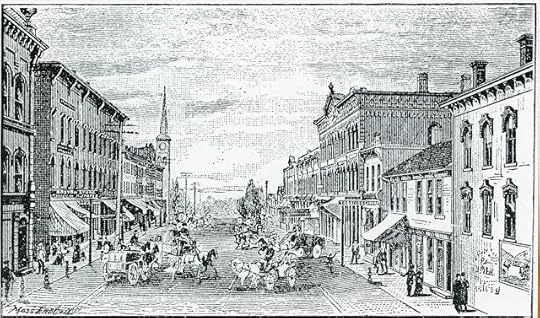 Broadway in downtown Salem, Ohio
Broadway in downtown Salem, OhioMessrs. Hudson, West, and Wilson, who left this place onMonday after the Battle of Murfreesboro for the purpose of procuring the bodiesof Captain Urwin Bean [Co. E, 19th Ohio], Thomas T. Hale [ Co. B, 65thOhio], Robert D. Wilson [Co. D, 19th Ohio], Joseph Bull [Co. B, 65thOhio] , Abner J. Crampton [Co. B, 65th Ohio], and Benton Speakman [Co.B, 65th Ohio] returned on Tuesday evening of last week at 10 o’clockwith the above bodies except Crampton’s which they were unable to procure.
Mr. West arrived at home on the Sunday morning previous,leaving the bodies in charge of Hudson and Wilson. Mr. West left the party atElizabethtown, Kentucky, some 40 miles south of Louisville, the snow being sodeep, some three feet, that the train was unable to proceed further. Mr.Hudson, seeing no chance of getting to Louisville by rail, hired a wagon andeight horses to take the bodies by the Lebanon Pike to Louisville, 46 milesthrough the snow. At Louisville, they came by boat to Cincinnati where theywere again placed on board the cars and safely arrived as we stated above.
Although the night was a dismal one, quite a large number ofour citizens were at the station to receive the bodies and have them conveyedto the town hall where they were to be dressed before delivering them to theirfriends. We could not, at this time, but notice the marked difference in themission of those here congregated on this cold, stormy winter’s evening withthose who had assembled over a year ago to bid the same young men, whoselifeless and lacerated bodies lay before them, the last farewell and a heavyGodspeed in the service of their bleeding country.
But tonight, how changed! The earth is robed in a whitemantle and the cold winds of mid-winter are hurling the rain and snow on everyhand, a fit emblem of the occasion. Back then, the beautiful autumn hadshowered her richest treasures upon us and our hearts were light. A sad change hascome over that scene and we are walking amid the wreck of a bloody battle asthe rude boxes before us attest. We hear not the cannon’s roar, nor the quick,sharp crack of the rifle, but here are the remains of a few of the brave menwho participated in that death struggle and have given their lives for thecountry they loved.
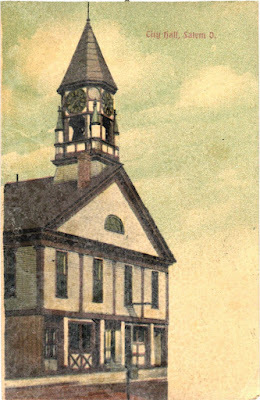 Salem City Hall
Salem City HallLocal History Collection,
Salem Public Library
The bodies were conveyed to the hall with the exception ofWilson’s which was taken to New Albany where his mother resides. The roughboxes containing the dead were placed side by side on the platform of the halland were opened as speedily as possible. The first box opened contained thebody of Captain Bean; the next was Hale’s, and so on until all were opened.Among the few men present was an aged father whose son lay in a rude coffinbefore him. How eagerly he gazed at his boy and said, “That’s my son!” and leftthe room. Who can tell the agony of a fond parent for their child under suchcircumstances?
Few of us present on this occasion ever saw such a sight aswas here presented. There lay the bodies of four young men in the pride andglory of manhood, three of whom has been buried on the battlefield just as theyfell and presented a ghastly appearance which we do not feel like describing.Captain Bean had been buried in a coffin and did not look so bad.
As to the nature of the wounds, Captain Bean was shot in thebreast, the ball passing through his right lung, causing almost instant deathby suffocation. The hair on the left side of his head was clotted with bloodbut no signs of a ball mark could be found. The ball entered the right hip ofSergeant Hale, passed through him, and came out on the left side just below thehip bone. He was carried to the camp hospital nearby and did not die until thenext morning.
Joseph Bull was killed by a piece of shell which explodednear to where he was standing and struck his right side, just below the ribs,and passed through him making a frightful wound. A piece of the same shellwounded Lieutenant R.S. Rook who was standing near him at the time. BentonSpeakman was shot; the ball entered just in front of his left shoulder andpassed through his chest and bowels, coming out near the hip bone on the rightside. He must have been leaning over, or stooping down, at the time. He waskilled instantly.
The bodies, after being washed and dressed, were placed intheir coffins and on Wednesday morning they were delivered to their friends. CaptainBean’s remains were encased in an iron burial case and remained in the hallduring the forenoon and were visited by a large number of citizens. His body,in charge of his brother, was taken to Norristown, Pennsylvania for burialwhere his mother resides. Speakman was taken to the residence of Mrs. Maria Woodleynear Lynchburg in this county where he lived before he enlisted.
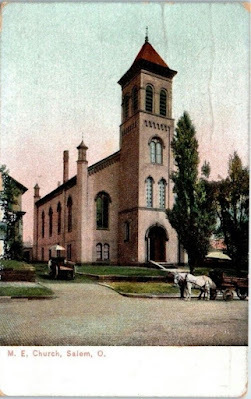 Methodist Episcopal Church
Methodist Episcopal ChurchSalem, Ohio
Local History Collection
Salem Public Library
The funeral services of Hale and Bull took place at theMethodist Episcopal Church on Broadway at 10 o’clock on Thursday the 22ndinstant. The hour appointed for the meeting at the church was announced by theringing of the town bell which was afterwards tolled during the services at thechurch. The principal stores and places of business were closed. The largeaudience chamber of the church was filled at an early hour by our citizens whoevidenced by their presence that this sad occasion was not a private but apublic grief.
The exercises commenced by singing an appropriate hymnfollowed by prayer by Reverend Stevens, and a sermon preached by Reverend C.H.Jackson from the 3rd chapter of 1st Corinthians, 22ndand 23rd verses, which read as follows, “Whether Paul or Apollos orCephas or the world, or life, or death, or things present, or things to come,are all yours. And you are Christ’s and Christ is God’s.”
We should like to have given a portion at least of the remarksmade on this occasion but we are unable to do so. Suffice it to say that thesermon was one worthy in every respect of the time and place. At the close ofRev. Jackson’s remarks, Rev. Stevens narrated the following incidents relatingto the death of these young men as told him by Mr. Hudson who learned the factsfrom their officers and companions in battle. After the recital of theseincidents, a song was sung by the choir befitting the occasion. Thecongregation then formed in procession and took at last view of the departedheroes. They were both buried in the cemetery.
Source:
“From theBattlefield,” Salem Republican (Ohio), January 28, 1863, pg. 2
October 11, 2025
A Ticket to Texas: Colonel Rutishauser's Travails at Camp Ford
Captured in the aftermath of the City Belle disaster in May 1864, Lieutenant Colonel Isaac Rutishauser of the 58th Illinois described the elation of his Confederate captors in the aftermath of their successes against General Nathaniel Banks' army.
"They took us to their camp, which was more like a bandit camp, such as I had seen in Italy in previous years, than a military camp," he relayed. "Here I was immediately surrounded by several Rebel officers, all of whom expressed their joy at their victory, which they had just achieved over Banks's mistakes. They mocked this general, called him their commissary, and claimed to have cut off and surrounded the Union army in Alexandria and could now starve them out."
And so began the colonel's lengthy imprisonment; eventually he would be delivered to Camp Ford, Texas, and remained there for nearly six months. Lieutenant Colonel Rutishauser’s account first sawpublication in the November 16, 1864, edition of the Illinois Staats-Zeitungpublished in Chicago. Special thanks to friend of the blog Randy Gilbert whodiscovered and translated this letter from its original German (in fraktur typeno less!) and to Vicki Betts who assisted with the translation.
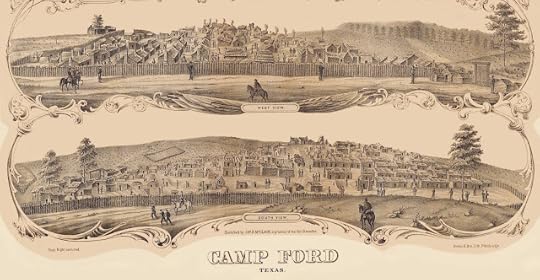 This depiction of Camp Ford, Texas was drawn by James McLain of the 120th Ohio, a fellow prisoner captured during the City Belle Disaster. (Courtesy of Randy Gilbert)
This depiction of Camp Ford, Texas was drawn by James McLain of the 120th Ohio, a fellow prisoner captured during the City Belle Disaster. (Courtesy of Randy Gilbert)
The brave Lt. Col. Rutishauser of the 58th Illinois Regiment,who was taken prisoner by the Rebels on the Red River last May, and wasrecently exchanged, has shared with us the following interesting account of hisexperiences in the South.
To theeditors of the Illinois State newspaper,
Please allow me to give you a brief account of my capture andmy fellow prisoners' experiences in Texas.
On February7, I was released from McPherson Hospital in Vicksburg with a leave of absence.After recovering somewhat from my illness, I went to Cairo, where I reportedfor duty on April 11to General [Mason] Brayman, commander of the Cairo District, and receivedorders to wait for my regiment, which had been reassigned with the 16thArmy Corps and was not easily accessible to me, as it was in Louisiana.
On the 25th, I reported to General [Stephen] Hurlbut,the corps commander, and received orders and transportation from him, but noopportunity to join the regiment.Three days later, an important dispatch arrived from Washington for General [Nathaniel]Banks and Commodore [David D.] Porter, and I was entrusted with its delivery. Itherefore left Cairo on April 29, and upon arriving in Memphis, by order ofGeneral [Cadwallader C.] Washburn, was given the gunboat Monank (Monarch?)at my disposal. On May 3, I advanced with it to about 30 miles belowAlexandria, when the commander informed me that he could go no further due tothe low water. I therefore considered it best to embark aboard the transportship City Belle, which was following us and had the 120thOhio Regiment on board, in order to deliver my dispatches to the scene.
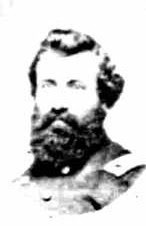 Colonel Marcus Speigel
Colonel Marcus Speigel120th O.V.I.
However, I had barely been on the ship for 10 minutes when wewere suddenly subjected to heavy fire from artillery and small arms. The secondcannonball destroyed the pilothouse and killed the pilot, and the fourth destroyedthe steam boiler, rendering the ship unsteerable. Many soldiers jumped into theriver to swim to save themselves. The three colonels on board, [Marcus] Spiegelof the 120th Ohio Regiment, [John J.] Mudd of the 2nd IllinoisCavalry Regiment, and [Chauncy J.] Bassett of the 96th U.S. ColoredTroops were killed, along with many other soldiers.
The ship itself was swept ashore by the current on theopposite side of the enemy, whereupon I quickly crawled ashore and fluttered tothe hill under the fierce fire, but without being injured. The boat was sunkinto the shore.
After I wasout of the area of the fire, I destroyed my military orders as a dispatchcarrier and handed the dispatch itself to a private from the 120thOhio Regiment, whom I took along as a companion, intending to carry it on footto Alexandria. During the night, we followed the river for about 20 miles, butour hopes of reaching Alexandria were soon dashed when, unfortunately, weencountered a pile of cotton bales, behind which about 25 Rebels were hidden.They immediately captured us, set fire to the cotton, and marched back the sameway we came.
They took us to their camp, which was more like a banditcamp, such as I had seen in Italy in previous years, than a military camp. HereI was immediately surrounded by several Rebel officers, all of whom expressedtheir joy at their victory, which they had just achieved over Banks's mistakes.They mocked this general, called him their commissary, and claimed to have cutoff and surrounded the Union army in Alexandria and could now starve them out.On the same day, I was taken to Chennyville, but first I was joined by theprisoners of the 120th Ohio Regiment. After marching for seven daysthrough pine forests, bypassing Alexandria, we arrived in Nacatorche(Natchitoches) on May 10th, were transported by river to Shreveport, and fromthere, about 110 miles away, on foot to Camp Ford near Taylor (sic), Texas. Imyself had to be left behind in the so-called hospital in Marshall due toillness.
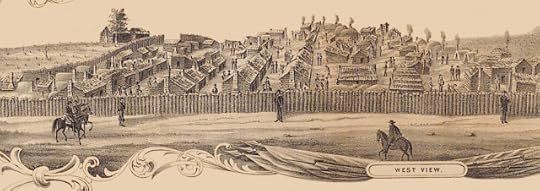 Detailed view of Camp Ford, Texas. Lt. Col. Rutishauser said that the name "camp" was a misnomer "for it was a six-acre cattle yard enclosed by tall, thick posts placed close together. The prisoners are driven into this enclosure like a herd of cattle and there they are left to make their own beds on the ground as best they can." (Courtesy of Randy Gilbert)
Detailed view of Camp Ford, Texas. Lt. Col. Rutishauser said that the name "camp" was a misnomer "for it was a six-acre cattle yard enclosed by tall, thick posts placed close together. The prisoners are driven into this enclosure like a herd of cattle and there they are left to make their own beds on the ground as best they can." (Courtesy of Randy Gilbert)After three weeks, and before I had recovered, I, too, had tomarch to Tyler, accompanied by a captured staff officer from General Banks,despite my protests and citing my poor health. Arriving at the camp, I foundthe captured officer prisoners of the 120th Ohio Regiment in a hutthat they had built themselves out of wood and that offered protection from theburning sun's rays, but not from storms and rain.
I am incorrectly using the name "camp" here todescribe the place where we were imprisoned, although it does not deserve it,for it was a six-acre cattle yard enclosed by tall, thick posts placed closetogether. The prisoners are driven into this enclosure like a herd of cattle,and there they are left to make their own beds on the ground as best they can.The camp commander showed so much humanity that he allowed the prisoners, underguard, to fetch bushes and shrubs from the nearby forest so that they couldobtain some protection from the heat of the sun. This humanity, however, wasvery cheap, and in his other treatment of the prisoners, he was so inhumanethat he had some of them shot dead from outside the enclosure without theslightest cause. He is also the author of the order that authorizes any Rebelsoldier or citizen to shoot at will any Union prisoner attempting to escape.
Before I speak further about this enclosure, I must return toour marches. For two days we had nothing to eat except a small so-calledbiscuit, a tuber kneaded together from water and flour. Later, we were givencorn flour in very small quantities and quality. However, since we had nocooking utensils, each of us provided himself with a board on which the flourwas mixed with water in the evening and roasted over the fire without salt.Finally, pork and beef were also delivered, which we stuck on sharpened twigsand roasted over the fire. At night, we slept without shelter, most of uswithout blankets, on the bare ground. I myself was fortunate enough to keep mywatch, which I bartered with a Rebel soldier after a few days for a usedblanket that had been taken from under a horse's saddle. My money was stolen bya Rebel guard on the very first night, as I fell asleep after a weary march.The thief, who returned the empty wallet to me, received no reprimand from hiscommanding officer, Captain Hendriks, 6th Texas Cavalry Regiment,when I complained to him.
The Ohioans fared no better; the night before we arrived atcamp, they were combed and searched by the Rebel guards, and under threat ofbeing shot if they resisted being plundered. At Camp Ford, the men are providedwith cornmeal and beef, which is distributed equally. This, apart from a littlesalt, is the only food available, and it is therefore no wonder that thehospital is full and the sick roam the camp by the hundreds. The prisonerscannot procure vegetables, for even if they have money, access to theseprovisions is blocked. I myself was once granted the privilege of receiving anorder allowing me to bring two watermelons into camp for my own use.
However, afew prisoners of Irish descent, who enjoyed the favor of Colonel Border, wereonce granted the privilege of trading in foodstuffs subject to a tax of 25percent of the value. This tax, it was said, was intended to benefit thehospital. The Rebel Dr. [Thomas W.] Meagher of Tyler, who was in charge of theoperation, never received any of it, so it can only be assumed that the colonelused the money for his own purposes. Mycomrades in the field will do well to remember the names of Colonel J.P. Borderand his adjutant, B.W. McEachem, both of whom treated the prisoners in the mostoutrageous manner, so that if they ever get hold of them, they can pay them inkind.
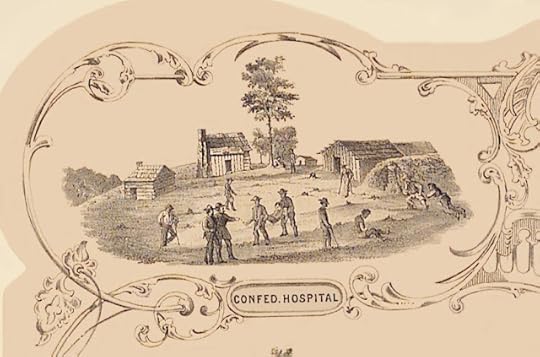 The hospital at Camp Ford as drawn by James McLain of the 120th Ohio
The hospital at Camp Ford as drawn by James McLain of the 120th OhioFrom time to time, some wheat flour also arrived at the camp.It cost 50 cents in greenbacks per pound. Sugar cost $1.75 per pound, pork$1.00, butter $1.75 per pound, a gallon of molasses $6.50 per pound, a quart ofmilk $1.00, and onions $1.00 per dozen. For several days, Col. [George] Sweet [15thTexas Cavalry] has been the post commander. He asked me to take over thesupervision of the camp and gave me the necessary orders. I devoted myattention to cleaning the camp in a military manner, which mainly improved thehealth of the people. I visited the sick, tried to cheer them up, and gave themmy advice as best I could. This is about all that can be done for them. We haveno proper doctors there; The few gentlemen who consider themselves such, butwho understand nothing of medicine, contribute not a little to the increase inthe number of burial mounds. Medicines are also in short supply.
During the course of my duties, I monitored the supply ofrations and discovered a deficit of 8,287 corn meal rations for 3,070 men in 17days. Considering the quality of this food, it is easy to see that theprisoners must have suffered greatly from such deception. I lodged a complaintagainst this injustice and thereby somewhat improved our situation, but I couldnot prevent us from later being given unmilled corn when the mill broke down.Fortunately, we had some good craftsmen among us, whom I immediately employedto repair the mill to protect us from starvation.
Col. Sweet allowed some of his men to go into the woods withthe prisoners to gather brush for the camp and huts, but after a few days, thisprivilege was revoked, as it was considered too inconvenient for the guards toconstantly run into the woods. Indeed, it required the service of two men fortwo hours a day to enable the poor prisoners to seek shelter from the burningsun and the rain, and to grant this is too generous. Such conduct exposes themen's lies when they excuse themselves for not being able to treat ourprisoners better and pretend to give them what they have.
I was almost overwhelmed by my duty, in which I could not beof any significant use to my fellow sufferers, and therefore submitted myresignation, which was granted. It is a sad sight to see about 3,000 men,mostly without blankets, in ragged clothing, and fed as described above,crammed in as we were. Therefore, no words can describe the joy I and 600 of myfellow prisoners felt when we left the camp on October 1st to beexchanged. On the way to Shreveport, we met a wagon train containing clothingand blankets for 1,200 men, which our government, accompanied by two Unionofficers, sent through the Rebel lines to our prisoners. These items will warmnot only many a body this winter, but also many a heart at Camp Ford.
With the 600 lucky ones, I traveled on foot, but at a lightpace, to Shreveport. Here, part of the crew was sent by boat and another partby land to Alexandria. It took us no less than 21 days to reach the mouth ofthe Red River, where we were exchanged. I need not describe the feelingsaroused in the people by the sight of the Star-Spangled Banner. The poor souls,almost all of whom were half-naked and barefoot, were reclothed in New Orleansand thoroughly enjoyed Uncle Sam's hearty rations, so that they would soon beable to devote their services to the country again.
I.Rutishauser, Lieut. Colonel, 58th Illinois Regiment
Isaac Rutishauser (Rutishowser/Rutsehaucer) was born 18 July1810 in Amriswil, Switzerland, emigrated to the US in the late 1850's and wasnaturalized on October 17, 1859. The 1860 census shows him as a saloon keeperresiding in Somonauk, Illinois, a village in northcentral Illinois west ofChicago. He was commissioned lieutenant colonel of the 58th Illinoison January 25, 1862, and saw action at Fort Donelson, Shiloh, Iuka, andMississippi. “For a long time, he was well and favorably known among our Germanpopulation,” the Chicago Tribune noted. “He was a brave and fearlesssoldier and at the battle of Shiloh he was wounded, taken prisoner, and held sixmonths before he was exchanged.”
The 58th Illinois saw service in the Red River campaignwhen Lt. Col. Rutishauser was trying to join them; this led to his capture May3, 1864. Following his release from Camp Ford on October 1, 1864, he wasdischarged January 27, 1865. “In 1865, he was appointed an Internal RevenueInspector and was legislated out of office in 1869,” the Tribune stated.“In 1873, he was appointed a Gauger which position he filled until 1876 whenthe whiskey troubles culminated. For 4 months past he had been employed in thepost office and had resigned his place, the resignation to have taken place fromthe 1st of November.” He collapsed of apoplexy and died October 23, 1878,in Chicago in the Grand Pacific cigar store of his son-in-law Louis Schaffnerand is buried at Graceland Cemetery in Chicago.
To learnmore about the loss of the City Belle which led to Lt. Col. Rutishauser’scapture, click here to read Captain James Taylor’s account in “Disaster atSnaggy Point with the 120th Ohio.”
Sources:
Letter fromLieutenant Colonel Isaac Rutishauser, 58th Illinois VolunteerInfantry, Illinois Statts-Zeitung (Chicago, Illinois), November 16,1864, pg. 1
“IsaacRutishauser,” Chicago Tribune (Illinois), October 24, 1878, pg. 8
“SuddenDeath of a Well-Known Citizen, Chicago Inter Ocean (Illinois), October24, 1878, pg. 8
The 157th New York and Dingle's Mill: A Final Fight in South Carolina
On one of the last days of the Civil War, Captain William Saxton of the 157th New York recorded his impressions of the April 9, 1865, fight at Dingle's Mill, South Carolina. His regiment, formerly part of the 11th Corps, had been pummeled at both Chancellorsville and Gettysburg before being sent to South Carolina in the summer of 1863. They were a veteran unit and when they deployed through the swamp at Dingle's Mill, Captain Saxton spied a pair of Confederate artillery pieces in his front and resolved to take them.
"I immediately formed my company in line, a few of the 56th New York boys falling in line with me, and marched them hurriedly to the edge of the woods, showed them the guns, then said, “Boys, let’s take them. Now, every man for himself as fast as you can go. Forward march!” And away we went. How rapidly a man’s thoughts will come to him under certain circumstances. I remember I thought as we were running forward that the muzzles of those guns were large enough for one to crawl into and I expected every second to see them fire into our faces. The distance was perhaps 200 yards but the Johnnies had gotten scared and attempted to hitch their horses to those guns and haul them off, but we were too near them and they cut the traces of those that were hitched and away they went. Their traces were cotton ropes. Some ran up the road west, some climbed the road fence and scattered into a field north. A squad of cavalry was in the road only a few rods away and as we rushed over that little fort, they all fled up the road. I was among the first to arrive and shook hands with one of the 56th New York boys across one of the cannons," he wrote.
These diary entries from Captain William Saxton, Co. C, 157th N.Y. saw publication in the January 17 & 24, 1902, editions of the Edgar Post published in Edgar, Nebraska.
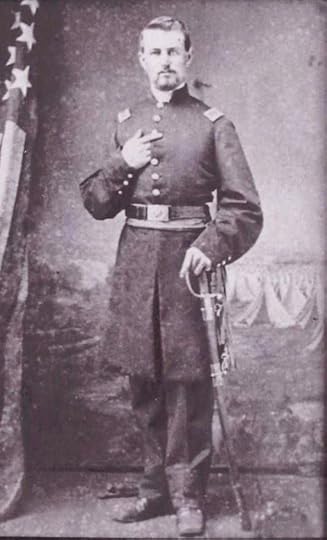 Captain William Saxton, Co. C, 157th New York Volunteers was a veteran of hard fighting at Chancellorsville and Gettysburg as well as service in South Carolina and along the Florida coast. The April 9, 1865, fight at Dingle's Mill near Sumter, South Carolina was the regiment's last engagement of the Civil War.
Captain William Saxton, Co. C, 157th New York Volunteers was a veteran of hard fighting at Chancellorsville and Gettysburg as well as service in South Carolina and along the Florida coast. The April 9, 1865, fight at Dingle's Mill near Sumter, South Carolina was the regiment's last engagement of the Civil War.
April 5, 1865: GeneralE.E. Potter was in command of this provisional division which was composed oftwo brigades. Adjutant Baldwin of our regiment was A.A.A.G. and LieutenantCampbell was acting ordnance officer on General Potter’s staff. The firstbrigade was commanded by Colonel Brown of our regiment; the second brigade byColonel Edward N. Hallowell of the 54th Massachusetts.
Two companiesof our regiment were left at Georgetown under command of Major Place to guardthe post and the two companies (B and D) of the 56th New York wereassigned to duty with us and Lieutenant Colonel Carmichael commanded theregiment. The provisional division consisted of about 4,000 men of allbranches, infantry, artillery, and cavalry.
At 8 a.m., thecolumn started and marched northwest parallel to and south of the Black Riverthrough a level wooded country towards Kingstree. Before going far, the columnwas halted and all who thought they would not be able to endure a long marchwere allowed to return to Georgetown. We made a march of about 18 miles thatnight and at night three or four Rebels were captured by our pickets.
April 6, 1865: Startedat 6:30 [a.m.] and marched through the same kind of country. The weather isgetting hot again. Camp near the Black River about seven miles from Kingstree,having marched about 20 miles. I was brigade officer of the day and had chargeof the pickets at night.
April 7, 1865: On themove again at 7:30 [a.m.]. The Johnnies are accumulating in our front andharass us a little. They burned the bridge over Black River at Kingstree. Wekept to the left and passed Kingstree on our right, marching toward Sumter. Thecountry is more open and a wealthier class of people live here when they are athome. Camped ten miles beyond Kingstree.
April 8, 1865: Startedat the usual hour, 6:30 [a.m.] in the rain bit it cleared off before noon.Marched 20 miles, forded two streams, and camped at night near the littlesummer village of Manning. A dastardly act was committed here by the enemy’scavalry. We had a small detachment of the 4th Massachusetts Cavalryalong with us. In coming into the village on the advance, this squad of cavalrychased the Rebel cavalry out. One of the Rebels, finding himself hotly pressed,turned and held up his hands in token of surrender. Private Elias B. Pratt ofCo. C advanced to receive him and, anticipating no danger, when nearly to hisside the Rebel dropped his hands, seized his revolver, and shot Pratt in theface, killing him instantly. The Rebel then put the spurs to his horse andescaped. In the running fight that ensured, one of the Johnnie’s saddles wasemptied. This was the most dastardly act that came within my personal knowledgeduring the war.
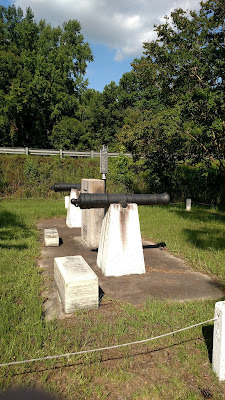 These are two cannons placed in their approximate positions at Dingle's Mill, an almost forgotten battlefield near Sumter, South Carolina. I visited the site, along along SC 521, in June of 2020.
These are two cannons placed in their approximate positions at Dingle's Mill, an almost forgotten battlefield near Sumter, South Carolina. I visited the site, along along SC 521, in June of 2020. April 9, 1865: Startedat 6:30 [a.m.] and marched rapidly all the forenoon. A number of cotton ginsand pressed were burned en route. We marched 14 miles in the forenoon and atnoon came to Dingle’s Mill where the road crossed a wide swamp with a streamflowing through the middle. The Rebels had town up the bridge across thisstream and flooded the swamp by cutting the dam to the right of the road. Theyhad erected a redoubt on a little rise of ground across the road on the westside of the swamp and as we approached, they sent a few solid shots across atus. General Potter halted the column out of range and gave the tired troops achance to eat their dinners.
After an hour’snooning, the 157th New York and 107th Ohio were ordered to flank the Johnnies out of their chosen position. ColonelCarmichael took our regiment and the two companies of the 56th NewYork to the left about a fourth of a mile and then turned west, parallel to theroad, marched down to the edge of that thickly wooded tangled swamp, halted,and had the officer’s call sounded.
He then toldus that we were to wade through that swamp and drive the enemy from theirposition. He said according to the best information obtainable; the swamp wasfrom a mile to a mile and a half in width and in places it would be waist deep.He instructed the company commanders to see that the men kept their ammunitiondry and have it ready for immediate use.
The difficultiesin crossing the swamp under the most favorable circumstances would requireconsiderable time and of necessity the regiment would become considerablystrung out as we would march by column of fours, left in front. If the enemystubbornly resisted our advance, it would take still longer time. In that swampand woods it would be impossible for the commander of the regiment to have aneye on the whole command and therefore each company commander (and especiallythose in the rear) must see to his own company. When we struck the hard groundon the other side, each must handle it as his best judgment would indicatewould be best in routing the enemy.
The order toadvance was then given. The marching of the regiment left in front brought Co.I in the lead and I do not recollect the order in which the other companiescame. My company was near the rear of the column, the two companies of the 56thNew York were ahead of me. As we entered the chilly waters of that swamp, whata shudder ran through our bodies! It was a dense wood with fallen logs andunderbrush with innumerable climbing, clinging, thorny vines extending from thelimbs of the trees to the ground. The natural obstructions to our progress weregreat and as before stated, the swamp had been flooded and the water and mirewere from knee to thigh deep as we floundered along.
Our progresswas naturally slow and the distance seemed longer than it actually was. Sometimearound 4 o’clock Co. I ran afoul of the enemy’s skirmishers along the edge ofthe woods on the west side and the firing at once became rapid and severe. Asthe head of the column emerged from the swamp while still in the woods, itdeflected to the right towards the road. Word was passed back for the othercompanies to hurry up as fast as possible; the firing all the time becomingmore rapid as the companies came out.
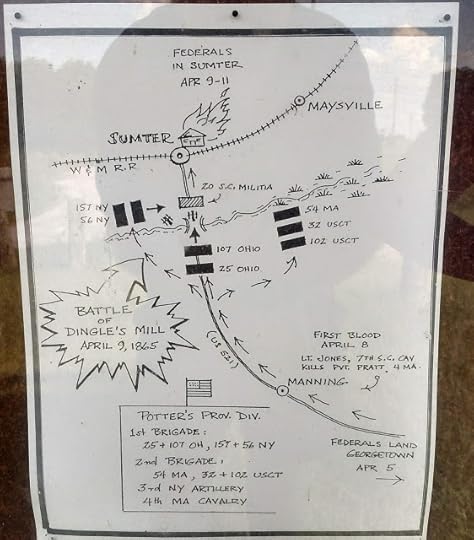 Map of the Battle of Dingle's Mill; the 157th New York hit the left flank of the 20th South Carolina Militia, perhaps 200 men in all.
Map of the Battle of Dingle's Mill; the 157th New York hit the left flank of the 20th South Carolina Militia, perhaps 200 men in all. When I struckthe solid ground with Co. C, I advanced to the edge of the woods west and sawacross an open field the earthwork referred to on a little knoll in the roadwith two pieces of cannon mounted in it. I saw at once (or thought I saw) if Icould form my company and charge across this field, I could take them in theflank and capture that battery before they could turn the pieces on us. I wouldbe charging along the hypotenuse of a triangle, the road being theperpendicular and the edge of the swamp along which the forward companies hadturned to the right being the short side.
I immediatelyformed my company in line, a few of the 56th New York boys fallingin line with me, and marched them hurriedly to the edge of the woods, showedthem the guns, then said, “Boys, let’s take them. Now, every man for himself asfast as you can go. Forward march!” And away we went. How rapidly a man’sthoughts will come to him under certain circumstances. I remember I thought aswe were running forward that the muzzles of those guns were large enough forone to crawl into and I expected every second to see them fire into our faces.
The distance was perhaps 200yards but the Johnnies had gotten scared and attempted to hitch their horses tothose guns and haul them off, but we were too near them and they cut the tracesof those that were hitched and away they went. Their traces were cotton ropes.Some ran up the road west, some climbed the road fence and scattered into afield north. A squad of cavalry was in the road only a few rods away and as werushed over that little fort, they all fled up the road. I was among the firstto arrive and shook hands with one of the 56th New York boys acrossone of the cannons.
We did not stop but for a momentin the redoubt. I rushed my men forward up the road a few hundred yards anddeployed them as skirmishers across the road and in the field to the north andsouth. As I was passing through the earthwork, one of my men picked up ablanket roll fastened with a shawl strap lying beside a dead lieutenant andhanded it to me saying, “Captain, this will keep you warm at night.” When Iunrolled that blanket, I found it was a lap robe, black on one side and greenon the other. I kept this and brought it home with me, using it for years. Ifound also in this roll a pair of cotton drawers and an undershirt which Igladly put on in exchange for the wet and muddy ones I was wearing. The rollalso contained a sick leave of absence signed by General Lee for thislieutenant. I kept this paper a long time and presume I now have it somewhereamong my papers but in the confusion incident to moving, I have mislaid it andcannot insert a copy of it here.
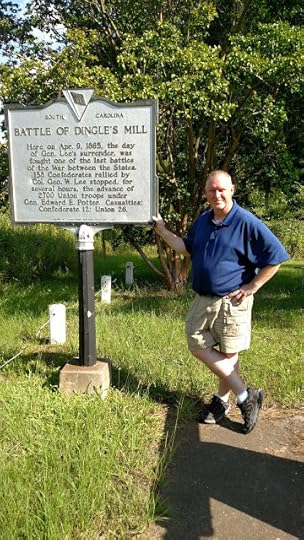 Yours truly at Dingle's Mill; signs on the site state to keep a close eye out for snakes but I never saw one, probably a good thing given my general distaste for reptiles.
Yours truly at Dingle's Mill; signs on the site state to keep a close eye out for snakes but I never saw one, probably a good thing given my general distaste for reptiles. Almost immediately after Co. Chad passed up the road, the other part of the regiment came charging up andcharged that battery again. In the fight of Dingle’s Mill or Sumter, Co. I borethe brunt of the fighting. Our regiment suffered 10 casualties, the 56thNew York, 15 and the 107th Ohio another 11. I have no means ofknowing what loss we inflicted on the enemy but presume their loss was not sogreat as they had the advantage of us, fighting on the defensive, and wereprepared to fire on the head of our column as it emerged from the swamp. TheRebel lieutenant in command of the battery was killed and left in the redoubt. Wecaptured the two pieces of artillery with ammunition and took them along withus, having them to use during the entire expedition, and took them back toGeorgetown with us and turned them over to the government.
After taking possession of theartillery, we marched on and after dark camped in Sumter, the county seat ofSumter County. The citizens had planned to give their boys a banquet after theyhad driven the invading Yankees back, but some of those refreshments foundtheir way into the empty stomachs of those invading Yankees. The boys capturedlarge quantities of peanuts and cigars.
During the 10th ofApril, the command remained in the city. E.H. Smith of Co. D, 56thN.Y. went into the printing office, set up, and printed a one sheet paper whichhe called The Banner of Freedom dated Sumter, S.C., Monday morning,April 10, 1865. Among the items in this paper was an article entitled “Acts ofBravery” from which I quote:
“In the affairs of yesterday, agallant act of bravery was performed which is worthy of commendation. When theorder to charge and capture the Rebel battery was given, Private Nathan Morseof Co. D, 56th N.Y. advanced ahead of his company on a keen run,scaled the breastwork which concealed the artillery, found four Rebels in thefort and ordered them to surrender, which they did. Captain Saxton of Co. C,157th N.Y. was the next to scale the earthwork and he and PrivateMorse shook hands across the guns. They were all the time exposed to themusketry of the enemy and liable to be captured at any moment as the Rebelcavalry were only a few yards to their left. Both escaped.”
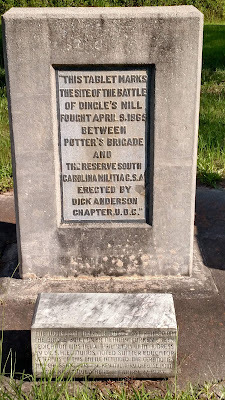 United Daughters of the Confederacy marker at Dingle's Mill.
United Daughters of the Confederacy marker at Dingle's Mill. In an editorial under the headof “The Duties of the Hour,” an address was made to the citizens of Sumter andto the whole state at large setting before them the fact that they had failedin their attempt to destroy the union by seceding therefrom. That they hadfought well and bravely, worthy of a better cause, but now they were beaten andthe union would be preserved. How would they accept the inevitable? They wereexhorted to take a common sense view of their conditions and yield gracefullyto the authority of the United States. It was believed if they would sue tocome back under the protecting folds of the stars and stripes and makeapplication for protection to the commander of the department, a guard would begranted them which would secure their persons and property against allguerillas or others who might seek to take advantage of the times to injurethem. A goodly number of copies of this paper were printed and distributed tothe houses of the city.
Sources:
War Reminiscences of Captain William Saxton, Co. C, 157thNew York Volunteer Infantry, Edgar Post (Nebraska), January 17, 1902,pg. 1; also, January 24, 1902, pg. 1
September 28, 2025
Nothing to Bind Us But Honor: In the Three-Months’ Service with the 87th Ohio
There isn't much written about the wartime services of the 87th Ohio Volunteers. Mustered into service in the summer of 1862 for just a brief 90-days, the regiment first guarded prisoners at Camp Chase before being sent to Baltimore, Maryland where it took part in the 4th of July celebration. A few days later, it was sent to Harper's Ferry where it became part of the garrison.
We are fortunate in that Private William A. Bosworth of Co. A, a student of Marietta College, provided the following lengthy description of the travails of the 87th to the August 22,1862, edition of the Pomeroy Weekly Telegraph. About 5 weeks after hewrote his letter, the 87th Ohio would be surrendered as part of thegarrison of Harper’s Ferry.
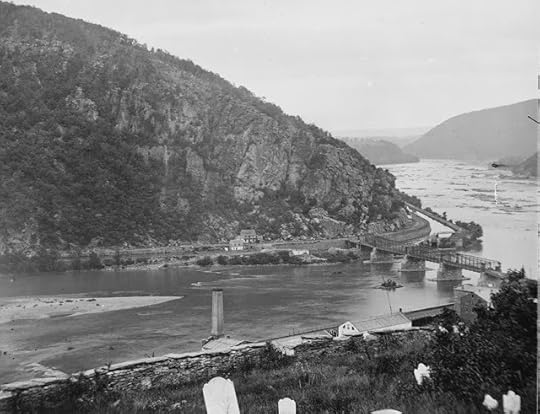 Maryland Heights as viewed from Harper's Ferry during the Civil War.
Maryland Heights as viewed from Harper's Ferry during the Civil War. Bowery Lane,Camp Banning, Harper’s Ferry, Virginia
August 4,1862
Being almost the sole representative ofold Meigs in the three months’ service and being connected with a regimentwhich has seen very many of the enjoyments and few of the hardships of soldiers’life, I may contribute my mite towards encouraging our boys to volunteer bygiving your readers a sketch of our adventures for the past two months.
When Governor Tod issued his call forvolunteers to serve for a limited period during the storm that seemed tothreaten our capitol, the citizens of Washington County called together by thepromptness and energy of Judge Putnam, chairman of the military committee, heldan enthusiastic meeting at which some 40-50 names were enrolled for 60 days.The students of Marietta College assembling at the courthouse with thecitizens, at a preconcerted signal, adjourned en masse to the College Chapelwhere after a brief deliberation, they agreed almost unanimously to holdthemselves in readiness to go.
The next day, when it was learned thatthe emergency was not so great as before supposed and that men would not beaccepted for less than 90 days, many though that duty did not call them to go.Nevertheless, we had quite a respectable company raised by night and the nextafternoon (Wednesday May 28) we started with about 75 men up the MuskingumRiver en route for Camp Chase.
I could hardly entertain you be describingat any length our trip to Columbus; I will only say that we had a pleasantjourney, finding amusement in responding to the cheers and waving ofhandkerchiefs that greeted us all along the way and withal feeling quite braveand patriotic as we attacked with valorous appetites the tables loaded withcrackers, cheese, and prime ham. We arrived at Columbus late Thursday eveningand marched up to the State House where we listened to a nice little speechfrom the governor, then marched back to the lunch of crackers and hot coffeewith quarters of the floors of an unoccupied tavern stand.
The next day, we took up quarters atCamp Chase and spent the first two weeks of our stay there in recruiting,organizing, arguing, and quarreling generally. We had come to camp entirelyunorganized and in fact, not regularly enlisted having nothing to bind us buthonor. In his call, the governor offered the choice of either going to protectWashington or remaining at Camp Chase to relieve troops doing guard duty. Thegreater portion of us, incited by a love of travel and adventure and willing toundergo danger if need be for our country, enlisted with the former intention.
But we had a few timid ones and anumber of boys who were bound by promises to their parents who intended tochoose the latter alternative. We gathered, however, from certain hints droppedby the governor that old Uncle Samuel had been more scared than hurry and thatthe dilemma now would be either to enter the general service, subject to theorders of the War Department, or the state service to be under the control ofthe governor. About three-fourths of our boys were still in favor of thegeneral service, but being induced by the persuasion of Judge Putnam and inorder to keep our company together, we at length reluctantly consented to enterthe state service and became Co. C of the 85th Ohio. We remained inthe 85th two weeks longer, making four weeks in the state service.
I presume Camp Chase is about as gooda camp as any similar one where large bodies of men congregate, though I shouldby no means recommend it as a place of summer resort. We had pretty goodshanties, very fair soldier’s grub, and the camp was well-policed but theground being bare, hard, and destitute of trees, the heat became veryoppressive when hot days did come which, thank heaven, were comparatively fewfor the season. The dust raised by the slightest breeze from the broad, flatparade ground, swept in almost blinding clouds; when the wind blew hard, thedust penetrated every crevice and cranny of our shanties. Just multiply thedust of Pomeroy by three and you will have about the product of camp Chase. Thewater, though not positively unwholesome, was not good, being strongly impregnatedwith sulfur.
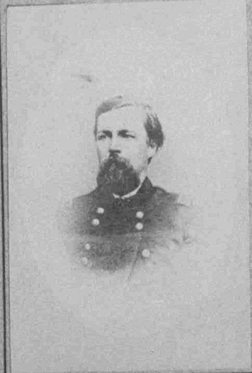 Colonel Henry Banning
Colonel Henry Banning87th and 121st Ohio
There were about 1,200-1,400 prisonersat Camp Chase. The prisons in which these men are confined are merely portionsof the camp enclosed by a close board fence 20 feet high with a walk near thetop for the guards. Our principal business at Camp Chase was, of course, toguard these prisoners- that is, to walk back and forth with a loaded guncarried in military position and keep them from coming within 10 feet of thefence. Such is the glory of state service. Among these prisoners may be foundall varieties of character from the wealthy and courteous Southern gentlemen tothe degraded ragamuffin bushwhacker. They all seem to be quiet and orderly withfew and occasional exceptions.
We soon became tired of this kind ofservice and when the opportunity of transfer was offered, about 20 of our menfrom the 85th and as many recruits we became Co. A of the 87thOhio. Our regiment was organized and ready for the march in a few days and onSunday morning, we started from camp under marching orders for AnnapolisJunction, Maryland.
Saturday afternoon we cooked our fiveday’s rations and got our troops ready. We awoke at 2 a.m. and were ready tomarch by 4. Marching from Camp Chase to Columbus for five miles was our firstand only hard march. I can assure the unsophisticated that even a five-miletramp with full knapsacks, five day’s rations, a gun, and ammunition to carryis not to be sneered at. I would as soon go 20 miles unencumbered. However, theboys bore up bravely and stepped firmly to the music as we passed through thestreets of Columbus.
We took the Ohio Central Railroad forPittsburg. What we most observed as we passed through the state was the numberand beauty of the ladies. At Newcomerstown, a mere village, there was a fullcompany of young ladies- a fine chance for young Benedicts. I suppose a portionof this praise of Ohio girls is owing to the fact that it was Sunday and thegirls were all out in their holiday attire which we passed through Pennsylvaniaon a Monday, which was wash day.
At the city of Smoke and Cinderswhere, by the way, the women are as homely as the houses, we changed cars,taking the Pennsylvania Railroad. Soon we began to ascend the mountains- up,up, along the banks of the Connewaugh, then down the Blue Juniata. There weremany fine scenes for the artist’s pencil along this route. The weather was delightfullycool and pleasant and I feasted my eyes to the full upon the grand panoramafleeting by us. The scenery on this side of the mountains is especially grand.High peaks and ridges tower blue and cloud-like in the distance. Down below us,half hidden in the trees, winds the Juniata River of song and tradition whileall varieties of mountain scenery unite to complete the picture.
Among the numerous towns upon ourroute, I must not forget to mention Huntingdon where we stopped for two orthree hours and were plentifully supplied with first-rate bread and butterwhich the ladies brought by the basket full. Well do they emulate thepatriotism of their husbands, fathers, and brothers, three companies of whomare in the service. It is their custom thus to minister to the enjoyment of allthe soldiers who pass through. God bless them! May their joys ever be asabundant as their charity is bountiful.
We arrived at Baltimore, Marylandearly Wednesday morning; we got off the cars and unslung our knapsacks,expecting to take the train for Annapolis when the order came to encamp. In themidst of a cold, drizzling rain, we pitched our tents upon a vacant space atthe northern edge of the city which we christened Camp Tod. This camp was lowand hot, but still better than Camp Chase as we had splendid water nearby and acreek upon one side and an old reservoir upon another which afforded greatconveniences for washing and bathing. Then we had a fine opportunity of seeingthe city when we could get a pass.
We had halted at Baltimore for thepurpose of being on hand on the 4th of July in case of a riot. Letme describe our day. At 4:30, we routed out and marched to town without our breakfastsand around the Washington Monument while everybody was asleep but a fewNegroes, draymen, etc. Squad and company drill in the morning and in theafternoon our first battalion drill for about two hours. Then about 5 o’clockanother tramp down the stony streets in the broiling sun and around the bigpile of white rocks, taking off our hats and giving cheers cheer at everystripe of the red, white, and blue which we couldn’t see for the sweat that pouredoff our faces. I must confess that when Colonel [Henry] Banning made us alittle speech and told us this was the proudest day of his life, we felt verymuch like the frog in the fable although we cheered him, of course.
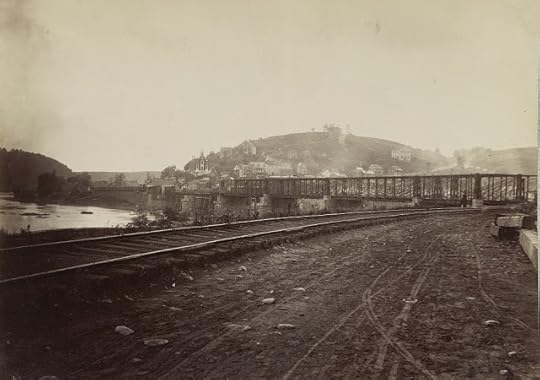 Harper's Ferry, Virginia
Harper's Ferry, Virginia On Wednesday July 9th wereceived marching orders again, this time for Harper’s Ferry. Three days ofrations to cook, another knapsack drill through Baltimore, a ride in the hogcars, and daylight finds us nearing Harper’s Ferry. As we turn a sharp curveapproaching this place, suddenly a most magnificent scene bursts upon thesight. Where the Potomac and Shenandoah unite their waters, they have cut adeep, narrow gorge through a ridge 700-800 feet high, leaving an almostperpendicular rocky wall upon either side. These rivers present quite asingular appearance. They are rather broad and quite swift, dotted thickly withrocks forming innumerable little water falls so that they presented a spottedappearance at a little distance. The scenery as you look up the Shenandoah isthe finest I ever beheld.
Again, in a drizzling rain we selectedour campground and pitched our tents. I will describe as well as I can oursituation and surroundings. Take as a starting point a street a mile in lengthrunning northeast and southwest through the towns of Harper’s Ferry andBolivar; the Ferry being at the northeast where this street divided the rightangle formed by the two rivers, the Potomac running east and the Shenandoahnorth. The town of Harper’s Ferry occupies the point formed by the rivers; theruins of the old arsenal buildings extending along both banks. Strongfortifications bristling with cannon extend across from stream to stream. Thetown of Bolivar is higher and extends along the street first mentioned. Here weare encamped about a mile from the Ferry in advance of the troops here.
Between us and the Potomac is a ridge. East across thePotomac from the Ferry are the Maryland Heights, halfway up which is a batteryof artillery with its guard of infantry. On the top of these heights is alookout built by the Secesh from which you can see the whole country for 20-30miles around. Ridges as high as our Pomeroy hills appear to be mereinequalities in the surface of a great valley which lies outstretched like amass at our feet. It is a view which will richly repay any one for the labor ofascent. South of us across the Shenandoah are the Louden Heights where we cansee some spiked guns, formerly a masked battery of our men. The troopsstationed here besides our men are the 12th and 22nd NewYork regiments, parts of a Maryland and Delaware regiment, and severalcompanies of artillery and cavalry.
We have had a good time since we have been here. Our camp isa very fine one with plenty of elbow room and a nice grassy drill ground. Whenwe first came to camp, we could get plenty of cherries from deserted premises.We now get apples and pears in the same way while picking blackberries andhuckleberries in the woods. For the past two weeks, our principal amusement hasbeen the construction of bowers of pine and cedar. I presume 10,000 loads ofbushes have been dragged into camp by our boys. We have built bowers in frontof all our quarters and fitted them up with seats and tables of Secesh boards.
We have built a tabernacle for meetings 40 feet by 80 feet,but the finest bower is one built by Co. A in front of the colonel’s quarters. Apine tree 8 inches in diameter is planted in the center, the upper boughs beingleft on; 8 smaller ones are set at equal distances from this, the raftersextended in a slanting direction to the center pole. Cross ticks are laid uponthese and the whole thickly covered with pine boughs. The center pole is finelyornamented with cedar full of berries and an octagonal seat is put up. Thestars and stripes float upon the top of the center pole.
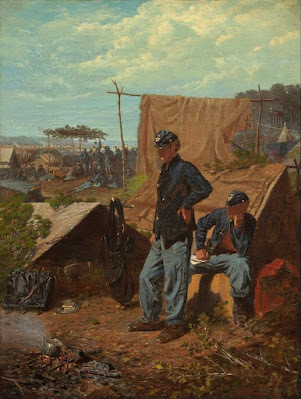
The bowers of our company are constructed upon a similarpattern but are not so fancy. I do not suppose we suffer as much from the heatas you do at home. We have no drills now after 8 in the morning or before 6 inthe evening. The rest of the time we can spend in our arbors. Besides we are onpretty high ground and have a cool breeze almost all the time.
As to the drill of our regiment, I will only say that we werehighly complimented by both General Wool and Colonel Dixon Miles at the reviewof the troops stationed here. Everybody says we have made very great progressfor the time we have been in the service. We do not expect to see any fightingbefore our time is expired though our boys are ready and, in fact, ratheranxious for a fight. Colonel Miles says that though the New York boys arebetter drilled, he would depend principally upon us in an emergency.
Our staff officers are all good men and well liked. Colonel HenryBanning is a captain in the service on a three month furlough. He is a goodmilitary man, very kind and sociable, and thoughtful of the interests of hismen but still strict enough in discipline. Lieutenant Colonel John Faskin is aScotchman with a voice like a lion and an air of unflinching courage which hasbeen well-tried, too. He was an adjutant in the service [67th Ohio]and won laurels at Winchester. Major Leffingwell was in the Mexican War and isthe best drilled man of the three. Surgeon Barr from the 36th Ohiois a No. 1 physician.
Our regiment is to be reorganized whenour time is out. I suppose our friends will be anxious to know what we aregoing to do. It seems to be settled than unless an emergency arises, we are toremain where we are until our regiment is taken back to Ohio to be reorganized.Rumors, many tongued, daily brings as to the time of our return and the placeto which we will be taken. The latest authentic report is that we are goingback to Camp Chase the last of next week to be immediately discharged and amonth’s furlough given to those who reenlist. Our term of enlistment does notexpire until the 10th of September.
[As things turned out, the 87th Ohio did not reorganize, the men disgusted by the way in which they were caught up in the surrender of the Harper's Ferry garrison on September 15, 1862, 5 days after the expiration of their term of service. Upon their arrival as paroled prisoners of war at Camp Douglas in Chicago, the men successfully lobbied to be sent home to Ohio where they were mustered out in early October 1862. William's older brother Milton Bosworth served in the 53rd Ohio and died of disease in March 1863. After his service with the 87th Ohio, William became a minister and died in Kansas in 1936, aged 94.]
Source:
Letter fromPrivate William A. Bosworth, Co. A, 87th Ohio Volunteer Infantry, PomeroyWeekly Telegraph (Ohio), August 22, 1862, pg. 1
September 26, 2025
With the Pointe Coupee Battery at Nashville
Scramblingback to the Pointe Coupee Battery’s position after spying the advancingFederals closing in on them, Rene A. de Russy recalled the thrilling finalmoments before the battery was overrun on December 16, 1864, during the Battleof Nashville.
“The battery suffered severely, men and horses going down inthe turmoil, a caisson being blown to atoms and Edgar Gueson being cut in by ashell. Still, the battery held fast, even when the men to the left had brokenand when the Union men came around the hill on the flank. Gun after gun wasserved until human endurance could go no further. Then with aparting shot into the very faces of Thomas’s men, Corporal Joseph H. Vienne andhis fellows started back under orders from Captain Alcide Bouanchaud. CorporalVautier trained his gun upon Vienne’s captured piece but without avail and theorder came to withdraw, several of the pieces first being spiked. The membersof the battery then made for the Granny White Pike, leaving over 20 dead andwounded within less than 100 yards of their guns. From that time on, theretreat partook the nature of a route and “suave qui pent” was the watchword.”
De Russy’s account of the second dayof the Battle of Nashville first saw publication in the May 20, 1907, editionof the New Orleans Times-Democrat. The battery was part of Myrick’sArtillery Battalion which was attached to General William Loring’s division ofGeneral A.P. Stewart’s Corps.
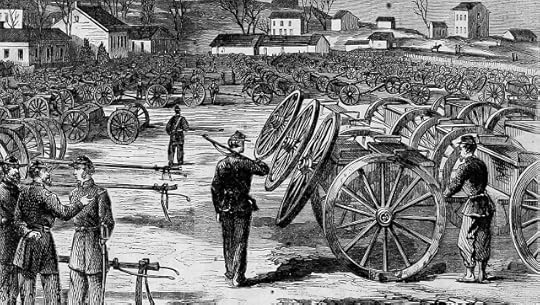 The spoils of war: the four 12-pdr Napoleons of the Pointe Coupee Battery are somewhere amidst this field of captured cannons and caissons gathered at General George H. Thomas's headquarters in Nashville in the days after the battle.
The spoils of war: the four 12-pdr Napoleons of the Pointe Coupee Battery are somewhere amidst this field of captured cannons and caissons gathered at General George H. Thomas's headquarters in Nashville in the days after the battle. At the opening of the second day’shostilities on December 16, 1864, the new line of the Confederates was locatedsome distance to the left of the Granny White Pike near the base of a high hillwith a running range of rock fence making a breastworks about four feet inheight and a range of trees skirting near the pike. The Pointe Coupee Batterywas the last battery near the base of the hill.
The Federal troops were extremelyactive and at times precipitated an onslaught which required a check from thebattery, driving the Union forces to shelter. Shortly before noon the rattle ofmusketry and the roar of half a hundred pieces of artillery gave notice thatthe Confederates on the right were engaged in a terrible battle and great wasthe suspense in the battery while awaiting news as to whether the tide ofbattle was running for or against the army. Could the old Army of Tennessee,with its thinned line, hold its own and gain further renown? This was thequestion that each man asked the other and the tension told on the nerves ofmany.
For three or four hours the battleraged and then came detachments of cavalry riding by, bringing the news thatthe day had been won for the Confederates and that Lee’s Corps had drivenThomas back in disorder and defeat. Thus encouraged, the Pointe Coupee Batterybraced itself with the rest of the wing for the general attack contemplated onthe front by the Union troops and awaited the onslaught of the seriedthousands.
In close marching columns the Federalscame forward, first opening on the Confederate skirmish lines and works withhalf a dozen batteries. On they came at the double quick for the Confederatebreastworks as the left wing of the Army of Tennessee braced to receive them.Out burst the blaze of the Confederate guns and the Federals paused in theirprogress and for a moment sought shelter, finding this cover behind a range ofhills which ran parallel with the Confederate lines.
Our battery was prominent in therepulse and performed its full share of the deeds of glory in the briefinterchange while General [William] Loring, but a short space distant, cheeredand waved his hat in encouragement. Noting that the Union forces had made anoblique move in their charge, the battery at once grasped the opportunitypresented and sent in heavy charges of grape with such telling effect that theright of the brigade was thrown into disorder and broke for cover with greatlythinned ranks.
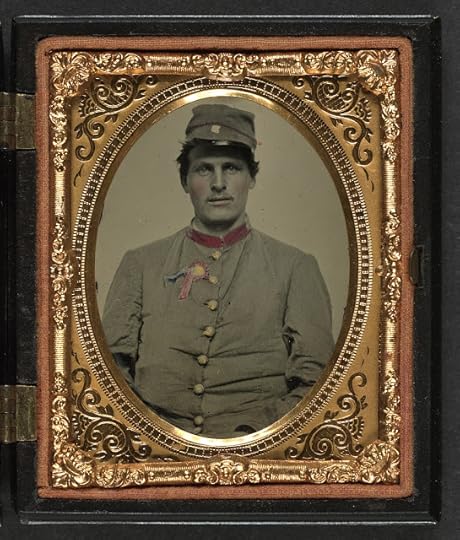 A proud Confederate artilleryman wearing a secession cockade.
A proud Confederate artilleryman wearing a secession cockade. Foiled in his first attempt, Thomaspaused and pondered, appreciating that direct attack was futile, and aretrograde movement took place with his forces. Taking advantage of the lull, Iclimbed a hill with some comrades intending to get a bird’s eye view of thesituation but was somewhat discouraged by the advent of a reckless shell whichdropped carelessly in my vicinity and dug a large hole in the hilltop. Beforewe could turn and flee, however, a second shell followed and decapitated ayoung Confederate, and warned the survivors that their range had been found bythe enemy.
Notwithstanding the shock of thisoccurrence, I with a friend from the battery threw ourselves on the ground andsquirmed to the edge of the hill where a view of over a mile stretched beforeus. Here we could see the moves and counter-moves of Thomas’s forces and theaddition of two batteries to the artillery gave us the realization that adesperate encounter was coming. Hardly had we rejoined our battery when GeneralHood rode up to General Loring and said, “General, if we can hold our line forhalf an hour or better, the victory will be ours.” His face was aglow with thebeam of hope and his eyes flashed with the fire of conflict; General Hoodpresented an inspiring sight to his soldiers and the Pointe Coupee Batterycheered him to the echo.
Then came the attack as Thomas’s armymoved onward. But, stubborn as was the onslaught, equally determined was thedefense and for hours the battle raged with blood flowing like water. Thebattery suffered severely, men and horses going down in the turmoil, a caissonbeing blown to atoms and Edgar Gueson being cut in by a shell. Still, thebattery held fast, even when the men to the left had broken and when the Unionmen came around the hill on the flank. Gun after gun was served until humanendurance could go no further.
Then with a parting shot into the very faces of Thomas’s men,Corporal Joseph H. Vienne and his fellows started back under orders from CaptainAlcide Bouanchaud. Corporal Vautier trained his gun upon Vienne’s capturedpiece but without avail and the order came to withdraw, several of the piecesfirst being spiked. The members of the battery then made for the Granny WhitePike, leaving over 20 dead and wounded within less than 100 yards of theirguns. From that time on, the retreat partook the nature of a route and “suavequi pent” was the watchword. That the defeat was a more bitter disappointmentto General Hood than the retreat at Moscow was to Bonaparte was the feelingwhich prevailed throughout the army. But the Pointe Coupee had fought the goodfight and had been faithful unto death.
To read more about the Battle of Nashville, please check out these posts:
The "Glory" Business: The 7th Minnesota at Nashville
William Keesy and the Battle of Nashville
A Carnival of Death: A Federal Officer's View of the Battle of Nashville (99th Ohio)The Troops Need Rest Very Much: A Confederate Reporter Writes After Nashville
Grab a Root! With the 111th Ohio at Nashville
Source:
“Record ofthe Pointe Coupee Battery in the Fierce Battle of Nashville,” Rene Amedee de Russy, New Orleans Time-Democrat (Louisiana), May 20, 1907, pg. 5
September 20, 2025
Picket Shots of Chickamauga with the Army of Tennessee
In "Picket Shots of Chickamauga" I'll share some of the shorter stories provided by veterans of the Chickamauga campaign that might not be long enough to constitute a blog post on their own, but make for insightful reading.
In commemoration of the 162nd anniversary of the second day of the battle, three accounts below give some perspectives from soldiers in the Army of Tennessee, including William Knight of the 36th Alabama who shares his memories of September 20th, George Jones war diary of Stanford's Mississippi Battery, and Captain John H. Martin of the 17th Georgia who 50 years later returns a corporal's commission he captured on the battlefield.
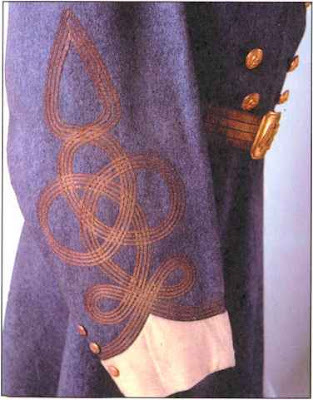 The detail of the lace on a uniform once worn by Lieutenant Braxton Bragg, commanding the Army of Tennessee at Chickamauga. The battle marked Bragg's one clear-cut victory over the Federals and it would be his last. His Army of Tennessee took enormous casualties defeating Rosey's bluecoats at Chickamauga and would be unable to full exploit that victory in the days afterwards. By the end of November, Bragg's army had been driven away from Chattanooga and Bragg asked to be relieved. Jefferson Davis finally agreed to do so.
The detail of the lace on a uniform once worn by Lieutenant Braxton Bragg, commanding the Army of Tennessee at Chickamauga. The battle marked Bragg's one clear-cut victory over the Federals and it would be his last. His Army of Tennessee took enormous casualties defeating Rosey's bluecoats at Chickamauga and would be unable to full exploit that victory in the days afterwards. By the end of November, Bragg's army had been driven away from Chattanooga and Bragg asked to be relieved. Jefferson Davis finally agreed to do so.
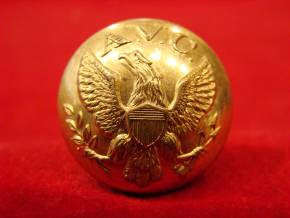 Alabama Volunteer Corps button
Alabama Volunteer Corps button
Chasing VanCleve’s Division in Clayton’s Alabama Brigade
The announcement of the death ofGeneral Henry D. Clayton vividly recalls to the mind of the writer the bloodyscenes of the Battle of Chickamauga where General Clayton fought so bravely anddistinguished himself so signally. The writer was a member of Co. C, 36thAlabama regiment but at this time was serving on General Clayton’s staff and isnow the only one of these staff officers that is left on this side of theriver.
His brigade was composed of the 18th,32nd, 36th, 38th, and 58th Alabamaregiment. The division was commanded by General Alexander P. Stewart ofTennessee. The battle was fought on the 17th, 18th, 19thand 20th days of September, 1863. During the last two days thehardest fighting was done and the heaviest losses sustained. Many of ourcompanies lost as many as 20 men and many of our bravest officers here pouredout their lifeblood. Among the number were Lt. Col. Richard Inge of the 18thAlabama and Major Jewett of the 38th. Lt. Col. Thomas H. Herndon wasseverely wounded and carried from the field.
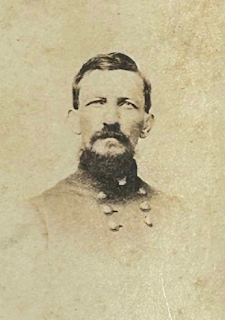 General A.P. Stewart
General A.P. Stewart"Old Straight"
On the 17th of Septemberthe first man was killed in the ranks of the 36th Alabama by acannon ball. The last charge was made on Sunday evening about 5 o’clock byClayton’s brigade on the division of Major General Van Cleve who was stronglyfortified behind a long line of breastworks constructed by cutting down largetrees. The charge resulted in a complete rout and almost entire capture of VanCleve’s division and ended the battle.
In the rear of van Cleve’s divisionwas a large old field and when the enemy were routed, this old field lookedlike a living mass of blue coats running pell-mell without regard to rank or file.It was here the gallant Clayton, followed by his staff and mounted men, dashedinto the midst and of the retreating mass and captured 4,000 prisoners; GeneralVan Cleve himself only escaping by possessing a fleeter horse than his pursuers,the officers of General Clayton’s staff. He finally reached the woods andsucceeded eluding us. I captured General Van Cleve’s portfolio, his papers, andphotograph, which I now have. I picked up on the battlefield a small bible withthe name of O.A. Mevis, St. Paul, Minnesota on one of the fly leaves and thefollowing epigraph: “The testament is of no force while the testator liveth.”If this soldier or any of his relatives are living and will write to me, I willgladly return it to them.
Source:
“Reminiscent:Recollections of Gen. H.D. Clayton at the Battle of Chickamauga,” CaptainWilliam N. Knight, Co. C, 36th Alabama Infantry, Troy Messenger(Alabama), November 7, 1889, pg. 1
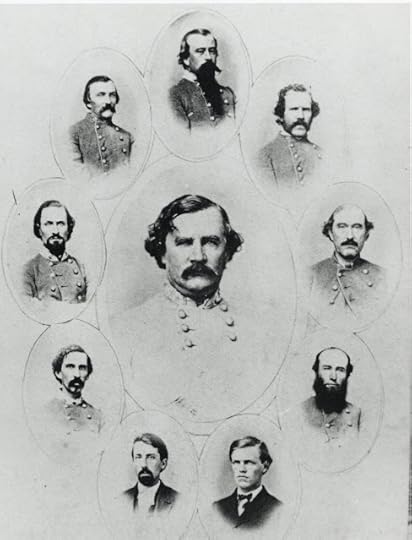 Division commander General Benjamin F. Cheatham and his staff in an image dating from 1863.
Division commander General Benjamin F. Cheatham and his staff in an image dating from 1863. War Diary ofStanford’s Mississippi Battery
Monday,September 7, 1863:Orders to march at a moment’s warning. Baggage packed in wagon at 10a.m. Ordersat 3 p.m. to be at McFarland’s, a distance of two miles, at sunset.
Tuesday,September 8, 1863:We rested our bones on the roadside last night; our horses remained standing inharness, ready to move in a moment. We are dirty as hogs. We moved off thismorning at 9, marching slowly, very dusty; marched 6 miles to Spring Creek;bivouacked in a large open field.
Thursday,September 10, 1863:At 8 o’clock we moved out from camp and marched two miles on the road toMcFarland’s, placed the guns in position, ready in case of attack on this road.Moved again at 8 o’clock tonight, crossed Chickamauga Creek about 10 o’clock.We are closing in upon the enemy; wouldn’t be surprised at a hard-fought battleany moment. General Rosecrans is said to have about 70,000 men.
Friday,September 11, 1863:We remained standing in the road all last night; moved again at sunrise;marched to the town of Lafayette, Georgia. It is now 4 p.m. The male academy isjust to our left.
Saturday,September 12, 1863:On the road at daylight; marched north to Rock Spring Church, 8 miles fromLafayette. Took position on the right of the road. Orders to build no fires.
Sunday,September 13, 1863:We stood by our guns all night; moved forward at sunrise. We advanced two mileson the Chattanooga road beyond our regular line of battle and took positionwhen we were ordered to shell the woods. We fired 70 times and did some goodshooting. We located a 10-lb rifle battery; they opened upon us and some oftheir shots came very close to us but most went over us. We fell back to themain line at dark.
Monday,September 14, 1863:Fell back to Lafayette again. We are marching and countermarching.
Wednesday,September 16, 1863:Ordered out on the road at 4 p.m. and marched one-and-a-half miles. We are nowcooking two days’ rations.
Thursday,September 17, 1863: Marchedout on the Ringgold road. Bivouacked at 10 p.m.
Friday,September 18, 1863:Moved forward a short distance at daylight. Heavy skirmishing throughout theentire day. Orders to stand by our guns.
Saturday,September 19, 1863: Itis now a little after daylight. We are moving in line of battle. We crossed theChickamauga this morning at 9 o’clock, having driven the Yankees from their strongposition. It is now 10 o’clock and the battle is raging all along the line. Ourright center is about to give way. There seems to be a gap between the left ofCheatham’s division and Hood’s right. Stewart’s division with our battery areheld in reserve and now are ordered to fill the gap. Oh, how awful, howfearful! It seems to be death itself. Stewart is making a gallant charge. Hehas broken the enemy’s center and is pushing forward. We are now under a heavy enfiladingfire. Our battery attempted to take a new position on a knoll of a ridge alittle in advance of the regular line. Just as we got nearly to the top of theridge a perfect hail of Minie balls and shells poured in on us. Wecountermarched in double quick time. Captain [Thomas J.] Stanford said to stay would meandeath to the entire battery in five minutes. John McNeal and Robert Burt werebadly wounded. It is now 4 p.m. A general advance is being made on the entireline. Volley after volley of musketry and the grand booming of artillery areheard all along the line. The Yankees are falling back slowly. It is now nearlydark. By 8 p.m., we are bivouacking on the bloody battlefield. General PrestonSmith was killed about dark while leading his brigade in a gallant charge.
Source:
“Old Soldier’sDiary: Mr. Geo. W. Jones’ Reminiscences Make Interesting Reading for Everybody,”Sergeant George W. Jones, Stanford’s Mississippi Battery, Grenada Sentinel(Mississippi), October 1, 1898, pg. 8
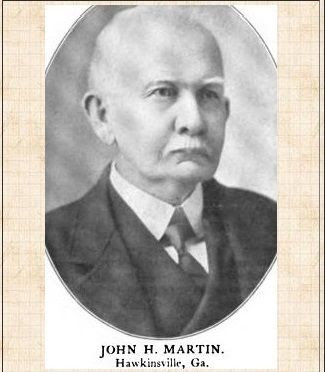 This postwar image of a determined looking Captain John Henry Martin of the 17th Georgia gives some sense of the character of this self-described "most unreconstructed Rebel you ever saw."
This postwar image of a determined looking Captain John Henry Martin of the 17th Georgia gives some sense of the character of this self-described "most unreconstructed Rebel you ever saw." Returning aBattlefield Trophy: a Letter from the 17th Georgia
In January 1913, Judge John HenryMartin of Hawkinsville, Georgia returned the long-lost corporal’s commission belongingto Thomas J. Rutledge, formerly of Co. F of the 8th Kansas Infantry.Martin had found it on the battlefield of Chickamauga on September 19, 1863,and wrote the following to Mr. Rutledge:
I was captain of Co. D, 17th Georgia Volunteers ofBenning’s Brigade, Hood’s Division, Longstreet’s Corps and we got to thebattlefield just after daylight on the 19th and were moved to ourextreme left, the Federal extreme right. Early in the morning of the 19th,Benning’s and Hood’s Texas Brigade were ordered to advance and did so. A friendof mine and I said we would be the first to strike the enemy and we dashedahead of the line and ran right into the 8th Kansas in the thickwoods. We ran right into the regiment and were captured for a short time.
Just after we got into the rear of the front of the regiment,a Federal soldier fired at me but a few feet distant but missed me and he waskilled. The fighting at this time was general and instead of the two sidesbeing in line, they were badly mixed up. Your side was holding up until a lotof Confederate cavalry with a yell dashed into the open on your right and rear(and our left). Then the Federals gave way and retreated, closely pursued byour troops and when our troops came up, I rejoined them.
We advanced up to the Lafayette road and by a cluster of oaksright be the side of the road where the Federals had had a battery; here I waswounded in the foot slightly. You will doubtless recollect where the batterywas located and when the cavalry dashed out. When the fighting stopped, I wentback to where I was shot at and found a dead man at the place as I near as Icould locate it. When the fellow shot at me, I did not notice him closely so asto certainly identify him for the fighting was then too furious forobservation. Close to this dead man was a knapsack which I took to be his andin the knapsack I found the commission and have had it ever since then. Ithought and have always thought until I got your letter that the owner of the knapsackand commission was the dead man and have so stated many times.
The next day, we moved to the right and were ordered to takean 8-gun battery that two or three brigades had tried in vain to take. We tookthe battery but lost nearly all our men. Every officer and man in my company waskilled, wounded, or hit with a ball. I was shot within 20 feet of the batterythrough my jaw, crushing it on both sides and from which I have never fullyrecovered. I was hit 11 times during the war, three of those wounds beingsevere. I was never in a Federal prison. I was captured on September 29, 1864,at Fort Harrison but got away as I had vowed that I would never surrender or betaken to a prison, preferring death. My company was captured by Lee’s surrenderbut I was not, being on detached duty near Danville, Virginia guarding theConfederate Cabinet against Federal raiders.
I was in skirmishes after Lee’s surrender and I have neversurrendered or been paroled but am today the most unreconstructed Rebel youever saw or heard of. I do not wear anything, except in midsummer, butConfederate gray. I do not, however, abuse or say hard things about the Federalsoldiers who fought us and some of my most loyal friends are old Federalveterans.
I know you will appreciate the commission and it will be amemento that you can leave your family.
Captain Martin died nine months later in Hawkinsville onSeptember 14, 1913, nearly 50 years to the day when he captured CorporalRutledge’s commission on the first day of the Battle of Chickamauga.
John Henry Martin was born April 10, 1842, in Decatur County,Georgia and enlisted in the 17th Georgia straight from college,entering the ranks a private but being quickly mustered as orderly sergeant. Hisservice record shows he was wounded at four battles: Second Manassas, July 2ndat Gettysburg, September 19th at Chickamauga, and May 6thduring the Wilderness. He was paroled May 20, 1865, at Thomasville, Georgia andreturned home where he became a judge.
Source:
“Lost in1863, Found in 1913. Commission dropped at Chickamauga Recovered,” Captain John Henry Martin, Co. D, 17th Georgia Infantry, Coffeyville Daily Journal(Kansas), January 22, 1913, pg. 6
To learn more about the Chickamauga campaign, please check out the Battle of Chickamauga page where you'll find more than 100 blog posts covering varying aspects of this important campaign.
September 19, 2025
Picket Shots of Chickamauga from the Army of the Cumberland
In "Picket Shotsof Chickamauga" I'll share some of the shorter stories provided by veterans of the Chickamauga campaign that might not be long enough to constitute a blog post on their own, but make for insightful reading.
In commemoration of the 162nd anniversary of the opening day of the battle, three accounts below give some perspectives from soldiers in the Army of the Cumberland, including Henry Dietrich of the 19th Illinois, Allen Fahnestock of the 86th Illinois, and Edward Molloy of the 87th Indiana. Tomorrow's post will feature three stories from their opponents in the Army of Tennessee.
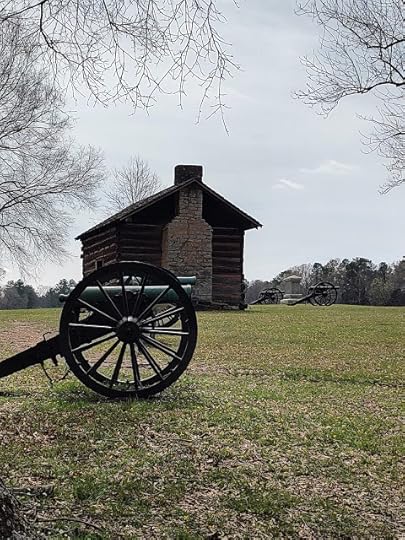 Brotherton Cabin
Brotherton CabinAt the Battle of Chickamauga, I was a private in the ranks ofCo. A of the 19th Illinois Infantry. I was one of the skirmisherssent out to feel the enemy. At the beginning of the battle, we advanced towardsa clump of woods to draw the fire of the Southerners. We had to cross a fieldcovered with stumps and piles of rails and a battery was stationed behind us tothrow shells into the Confederate ranks whenever we should draw their fire.
We had advanced a considerabledistance when the Confederates opened on us. We took refuge behind the railsand remained there firing until the recall was sounded. The battery all thewhile threw shells over us and into the woods. When we were going back afterthe recall, I missed a young soldier named Metcalf. Looking back, I saw himkneeling behind a rail pike. Another soldier and myself, thinking he must bewounded, we went back to get him. We found that a short shot from our ownartillery had literally blown off the top of his head but it had not caused himto fall. [The Illinois Adjutant General’s report states that Private Fred W.Metcalf was killed in action September 11, 1863, at Lafayette, Georgia.]
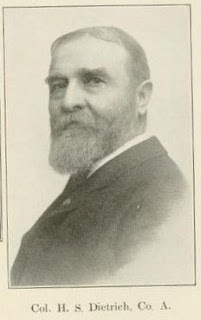 Private Henry S. Dietrich
Private Henry S. DietrichCo. A, 19th Illinois Inf.
On Saturday night September 19, I wason outpost duty. When relieved at midnight, I was thoroughly chilled. I wentback toward my company and on the way came upon a soldier lying beneath ablanket. Not having a blanket of my own, I crept under his blanket quietly tokeep from disturbing him. I did not awaken until morning. Then I turned to geta glimpse of my companion. He was a dead cavalryman and I had slept beside himthinking he, like myself, was only worn out from the day’s duties.
The next day, on Sunday September 20th,I had my experience in terrific fighting. Our regiment that day occupied SnodgrassHill, the key to the situation. There we remained until night. To make ourposition secure and afford us some protection, we tore down fences and log cabinsand built a walk just high enough to hide us when lying down. Immediatelybehind us were the cannons. Men still back of the cannons loaded our guns andpassed them to us and we reserved our fire for the charges which theSoutherners repeatedly made. At one time I had five loaded guns beside me. Whenthe enemy would come very close, we would fire these reserve guns as fast as wecould pick them up and take aim. The cannons boomed right over us all the timeand deafened several of the soldiers.
Source:
“Incidentsof Chickamauga,” Private Henry S. Dietrich, Co. A, 19th IllinoisVolunteer Infantry, New Washington Herald (Ohio), December 18, 1903, pg.12
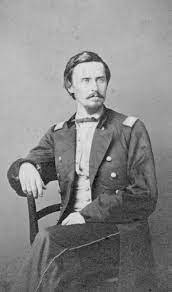 Colonel Daniel McCook
Colonel Daniel McCookThe FirstShots of Chickamauga
There is no question in my mind as towho opened the fight at Chickamauga. Our regiment, the 86thIllinois, went out with Colonel Dan McCook’s brigade on the evening ofSeptember 18, 1863, to destroy Reed’s Bridge across the Chickamauga. CompaniesB and I of the 86th Illinois were on picket on the right of theLafayette Road with Co. B under Captain [James P.] Worrell on my left and 20men of the 52nd Ohio on my right. The much-talked-of spring lay tothe left of Captain Worrell’s company.
Lieutenant [Richard W.] Groinger ofthe 86th and myself took charge of our post that night as I wasshort of men. I told Private Jacob Petty of my company that evening that therewould be a fight the next morning and said to him that if he shot a Johnny, Iwould buy him a plug of tobacco. The next morning at break of day, a Confederatecavalryman rode to our front. Petty saw him and asked Lieutenant A.A. Lee if heshould shoot. Lee said yes. Petty fired and brought down his man and that shotopened the Battle of Chickamauga.
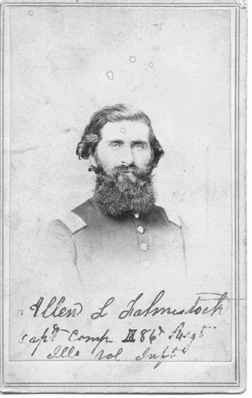 Capt. Allen L. Fahnestock
Capt. Allen L. FahnestockCo. I, 86th Illinois
Soon after Petty’s shot, firing beganon the left of Co. B at the spring. Captain Swift of Colonel Dan McCook’s staffhad ordered me to the top of the hill to fight the enemy back to the brigadeand Barnett’s battery. We carried out instructions to the letter but when wehad driven the enemy to where the brigade had been posted, there was no brigadethere. It had been ordered back as the enemy had crossed Chickamauga Creekabove and below and now pressed my small force on both sides.
About this time, General Thomas on myright or south of Reed’s Bridge, struck the enemy and the fighting becamegeneral. I claim that our brigade should have the credit of opening the Battleof Chickamauga and I contend that we closed it on the night of the 20that Cloud Springs, to my mind the key to the Union position. Petty, who firedthe first shot on the 19th, claimed his reward that evening.Lieutenant Lee notified me that Petty had got his man and wanted his plug oftobacco. Tobacco was scarce at the time, but I found a plug and paid $1 for itand sent it to Petty. The U.S. is indebted to me for that amount plus interest for42 years.
Source:
“Memories ofthe War,” Captain Allen Lewis Fahnestock, Co. I, 86th IllinoisVolunteer Infantry, Hocking Sentinel (Ohio), February 8, 1906, pg. 3
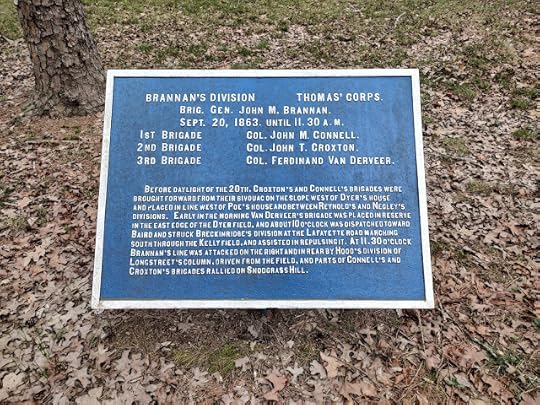
TheNarrow Escape that Led to Capture
The regiment to which I belonged, the87th Indiana, suffered a loss of 51% at the Battle of Chickamauga.Eight commissioned officers were killed and others were wounded. The sight thatmorning just before the battle opened was worth seeing. The 87thIndiana stood in close column by division facing a piece of woods. Just as thebattle opened, first a stray shot or two, then a roll of musketry, next theterrific roar of artillery.
General Rosecrans rode by with his staff and bodyguard,presenting a magnificent appearance. The general wore a sombrero and sat on hishorse as if he were monarch of all he surveyed. Just in the rear of thecommanding general was General Thomas and his entire staff, occupying a risingpiece of ground. A shell flew over us and reached the ground over whichRosecrans and his grand cavalcade were passing, but not a man dodged. Presently,General Garfield, simply armed with a huge field glass, rode over to ourregiment and inquired for General Brannan, the commander of our division.Adjutant Ryland replied, “General, I think he just rode into the woods,”pointing his finger in the direction indicated and that was the last we eversaw of any of those gallant generals referred to whose deeds of valor form sucha conspicuous and thrilling portion of our nation’s history.
The morning of September 20, 1863, the 87thIndiana and the Confederates confronting the regiment fairly fired into eachother’s faces. This is the united testimony of General Hazen of West Point andColonel Vanderveer of the 35th Ohio who commanded the brigade ourregiment was in at the time. General Hazen declared that he never before sawmen fire in each other’s faces as he did at Chickamauga except at the Battle ofShiloh, but there bushes intervened between the lines while at Chickamauga, thetroops of both armies fairly confronted each other.
Those who remained with the 87thafter the first encounter that morning stated unhesitatingly that theConfederates literally left the ground covered with their dead and wounded. Itwas a heroic struggle on both sides. The men of both armies stood their groundwell. Judging by the loss of the 87th during that morning’s dreadfulencounter and a casual glance at the depleted numbers as they started inpursuit of the Confederates, the 87th seems to have fairly meltedaway. The dead lay where they fell while the wounded sought some place wheretheir injuries could be attended to.
As I left the regiment on the forenoonof September 20 by reason of being wounded in the leg, I beheld some wonderfulsights. Just as I started, Pete Heminger of Mishawaka rushed past me anddropping on the ground exclaimed, “Oh, for God’s sake, give some water! I’mshot through and though!” The front of his blouse was covered with blood. Thecomrade who was assisting me, having no water in his canteen, I requested himto take my canteen and quench the thirst of the dying soldier.
Wounded comrades were hastening to therear from all sides. Presently, I encountered a commissioned officer who wasskulking. Next, two horsemen approached me, one shouting at the otherexcitedly, “For God’s sake, bring back that flag!” Off to the left, the Uniontroops were retreating in great disorder, the men running like frightenedsheep. It was evidently the time and place when and where the Confederates penetratedour lines, dividing our army. As I reached Chattanooga road, I beheld a perfecttraffic jam of wagons, caissons, and ambulances. Shells were flying overMission Ridge just to the left of the road and much confusion prevailed.
I perched myself on the lower step ofan ambulance but did not persist in remaining there as I deemed it hopeless toattempt to reach Chattanooga that way. So, I retreated into the woods after restingfor a short time and tried to persuade some comrades who were playing cards to helpme to the road I had just left. I thought it possible that I might procure passageto the city in some way not readily discernible, but the “brave” heroes ignoredme completely, so I was compelled to do the next best thing- help myself, whichI did by discarding everything but my canteen and haversack.
I walked quite a distance, although I was shot through theright leg just under the knee where the bullet narrowly missed an artery andboth cords of the limb. But excitement kept me up till I reached a stoppingplace where the surgeon pronounced the leg wound a “narrow escape.”
That night I slept in bed with a dead man, First SergeantSolomon E. Harding of LaPorte. He belonged to Co. G of the 87th andwas twice wounded, one or both wounds being mortal. At any rate, he passed awayat 2 a.m. after much suffering and when I awoke at daylight, he was cold indeath. That morning I was captured, the Union troops having fallen back in thenight leaving myself and the other wounded Union soldiers between the lines. Iwas on my way to Chattanooga when taken prisoner, the surgeons having advisedall of us that could do so to try and reach that place. Before starting, Iturned over all my rations to those left behind and the consequence was Inearly starved to death before being paroled and transferred to the Unionlines.
There was no attention paid to the wounded by theConfederates and no provision made for supplying prisoners with food until thelast two days that I was in their lines. Then something we designated as “slop”was issued to us. It was not thick enough for mush and too thin for gruel. Ithink it was made of bran and was cooked in large iron kettles used in thearmy. The prisoners were supplied with this three times a day. The kettles werepassed around and you helped yourself by dipping your cup into the kettle as itreached you. Each soldier was allowed to dip his cup in only once during ameal. If you were so fortunate as to possess a large cup, you received a largecupful, otherwise not.
Source:
“One of theWar’s Greatest Battles: Men Literally Fire Into Each Other’s Faces,” PrivateEdward Molloy (later Adjutant), Co. I, 87th Indiana VolunteerInfantry, South Bend Tribune (Indiana), May 22, 1912, pg. 4
To learn more about the Chickamauga campaign, please check out the Battle of Chickamauga page where you'll find more than 100 blog posts covering varying aspects of this important campaign.
September 13, 2025
Grab a Root! With the 111th Ohio at Nashville
TheConfederate line had buckled and was in full retreat at Nashville on December16, 1864, when Corporal Virgil Harris of the 111th Ohio saw a “chanceto earn his $13 a month.”
Not far ahead, he spied a Confederatetrying to haul away a “beautiful artillery piece.” He wrote, “I rushed upon theman with the cannon and seized one of his horses by the rein and ordered him todismount. This he declined to do and proceeded to rap me over the head with theloose end of the reins at the same time urging his team forward to break loosefrom a heavy wagon against which his wheel had caught. By this time, Barr hadarrived and stood near me and I felt then extremely bold. The man making nodemonstration calculated to convince me that he intended to dismount, Idetermined to use the whole power vested in me by the Constitution of theUnited States. Accordingly, I gave him a blow which sent him tumbling overbetween the horses. My gun not being loaded, he slipped out under the off-horseand started down the pike as fast as his feet could carry him. Neither Barr normyself ever went on another 'side campaign' without loading our guns.”
Corporal Harris’s account of Nashville first saw publicationin Brigadier General Richard Johnson’s A Soldier’s Reminiscences in Peaceand War first published in 1886.
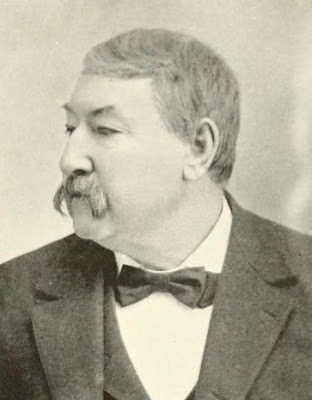 Corporal (later Orderly Sergeant) Virgil H. Harris, Co. B, 111th Ohio Volunteer Infantry
Corporal (later Orderly Sergeant) Virgil H. Harris, Co. B, 111th Ohio Volunteer Infantry
At the battle of Nashville, the Army of the Ohio commanded byGeneral John M. Schofield had fought its way into position on the right and layon the morning of the [December] 16th in line of battle facing tothe east at right angles with General A.J. Smith’s 16th Army Corpsand parallel to the Granny White Pike. From this position we were in full viewof the Harpeth and Brentwood ranges or hills. We had prepared our frugal meallong before the dawn of day and at sunrise could plainly see the Rebels on thetimber-covered slopes not far away. We were cautioned to remain concealed asmuch as possible and not to fire under any circumstances.
But our position was discovered and aRebel battery opened upon us would have been had they fallen and exploded inour ranks. When the whizzing sound of a shell was heard, the usual cry of ‘Graba root,’ ran through the line, the effect of which was to induce the braves toadopt the doctrine of squatter sovereignty without question. As time wore on,each warrior loved his country more in fact for they hugged it, embraced it,felt as if they wanted to get right down into it, at least far enough toshelter them from the fire of the enemy.
About noon, the firing of the cavalryon our right was music to our ears for we knew enough of the country to knowthat our men were in possession of or very near to the pike on the south of theBrentwood hills. On the other side of the low ridge occupied by us was onestill lower upon which ran a slight elevation of earth which mat have been atsome time a hedge. It was high enough to hide the form of a man on a levelplain and we were told that we were to occupy it as our next position.
At the given signal the entire linemoved rapidly and occupied it without firing a shot. Here we were concealedfrom the view of the Rebels. As soon as this movement was accomplished our oldposition was occupied by 30 pieces of artillery which opened up a most terrificcannonade upon the Rebel works not over 300 yards distant. The shots and shellsfrom our own guns tore the tops and limbs from the huge oaks in our front andrear. One large limb fell on our company and spread its whole length, the heavyend striking James Bemis and knocking him senseless. Another came near killingJames Carter while the switch end struck me just below the cartridge box,calling to mind by school-boy days. A charge of buckshot could not have painedme more than did the switching that limb gave me.
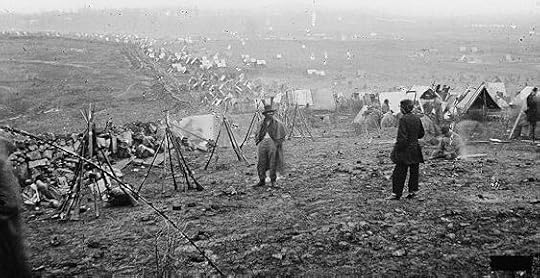 The Federal army in line at Nashville
The Federal army in line at Nashville The smoke of the cannons settled inthe valley, enveloping us and concealing from our view both friends and foes.And now the rattle of musketry, like an unceasing hailstorm, kept time with thedeafening roar of artillery. The earth and the mighty oaks trembled and shookagain with the echo that came back from Brentwood’s quivering crest. TheConfederate works were levelled with solid shots and their brave defenders laycrouched to earth. No Rebel yell arose above the deafening din. The stars andbars were furled forever, and freedom’s flag waved in triumph over the bloodyfield.
The pass through the Brentwood Range,through which the Granny White pike was made, was in plain view. No field ofbattle ever presented a landscape so plain, so beautiful as this. Our artilleryhad not only ruined the defenses of the enemy but had dashed the timbers tosplinters on the sides of the hill beyond. Shots, shells, and Minie balls haddriven the teamsters and skulkers in the Rebel rear to wild desperation. Therewas no escape for them except by the pike and now, in a moment’s lull, therecame a living stream from east and west which meeting on the pike, brokepell-mell for the Southern confederacy.
This host was governed by no order, but there in view offriend and foe they lashed their jaded steeds in a furious race towards theBrentwood Pass. As soon as this movement was discovered, our artillery openedupon the fugitives and in their rapid flight, they so closed up that it wassimply impossible for them to move. Many abandoned their wagons, mules, andhorses, then fled for safety in the hills. Bull Run never presented such utterdemoralization as was visible in the Rebel rear.
The victorious Federals required noorder to advance. With a yell that seemed to shake the foundation of the everlastinghills, 10,000 men from older fields than this rushed forward in pursuit of abeaten enemy. The war in the west was ended. So sudden was the change in theform of government in the eyes of our late foes that they laughed and clappedtheir hands, more pleased than we were over the situation. I heard one lean,lank cadaverous prisoner say, “You licked us at Franklin because you had moreto eat than we had. Can’t you give me a cracker?” We divided our rations. Why,bless your soul, we would have given them the coats off our backs. No shout ofvictory was raised over the surrendered foe.
And now came a small campaign not laiddown in Pap Thomas’ original plan of battle. Several hundred yards in front ofwhat had been the Rebel rear lay immense quantities of broken and abandoned warmaterials of Hood’s invincible legion for men were never braver than they. ThomasBarr, my chum and messmate, accompanied me as it was the duty of every soldierto get there. About 100 yards from our line and on the left of the pike, myeyes fell upon a picture, not painted, that I shall never forget. An oldcitizen appears to have entered the Rebel lines for the purpose of sellingmilk. He was seated in an old-fashioned one-horse shay. The horse had beeninstantly killed by a cannon ball. The old man was dead and had fallen forwardand hung over two large milk cans and, in his hands, he held the reins. Iraised his face but all was still. The milk was wasting through holes made byMinie balls and slowly dropping through the loose bottom of the vehicle.
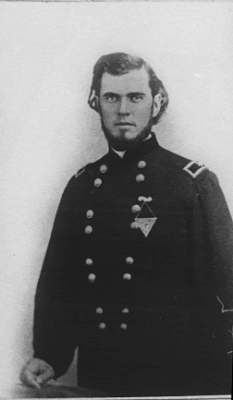 Lt. Col. Isaac R. Sherwood
Lt. Col. Isaac R. Sherwood111th O.V.I.
Barr laid his gun down and seemedindisposed to push his investigation any further, but soon realized thenecessity of prompt action, and onward we journeyed. We were not long inreaching the point for which we started. Here we had a fair view of the horrorsof war. Dead men were strewn upon the ground on a common level with dead horsesand mules. There we saw horses and mules uninjured, but held in place by a deador badly-wounded mate and I could read the despair in these poor, dumb brutes.
A short distance off I saw threeRebels working like demons removing obstructions towards the left while upclose to them and near the fence rode a graycoat with two horses drawing off abeautiful piece of artillery. It occurred to me that it was a good opportunity forme to earn my $13 a month and I resolved then and there to capture that gun. Icharged upon the lingering quartet and demanded their surrender in the usualpleasant army form. The three working heroes in front jumped over the fence andwere soon out of sight. I rushed upon the man with the cannon and seized one ofhis horses by the rein and ordered him to dismount. This he declined to do andproceeded to rap me over the head with the loose end of the reins at the sametime urging his team forward to break loose from a heavy wagon against whichhis wheel had caught.
By this time, Barr had arrived and stood near me and I feltthen extremely bold. The man making no demonstration calculated to convince methat he intended to dismount, I determined to use the whole power vested in meby the Constitution of the United States. Accordingly, I gave him a blow whichsent him tumbling over between the horses. My gun not being loaded, he slippedout under the off-horse and started down the pike as fast as his feet couldcarry him. Neither Barr nor myself ever went on another side campaign withoutloading our guns.
Back to camp we went with our captures, meeting on the wayour colonel Isaac Sherwood who thanked us for what we had done and promisedthat our prowess should be suitably announced in orders. But as we did notoccupy the same camp two successive nights for five months, there was no timefor making out congratulatory orders. This battle closed the rebellion in theSouthwest.
Source:
Letter from Corporal[later Orderly Sergeant] Virgil Homer Harris, Co. B, 111th OhioVolunteer Infantry, as quoted from Richard W. Johnson’s A Soldier’sReminiscences in Peace and War. Philadelphia: J.P. Lippincott, 1886, pgs.293-298
September 12, 2025
The Ladies Will Not Think Less of You: General O.O. Howard Loses His Arm at Fair Oaks
It is Mondaymorning, June 2, 1862. The day after having his right arm amputated at theBattle of Fair Oaks, General Oliver O. Howard met a fellow amputee at Fair OaksStation, General Phil Kearny.
“They dismounted and stood near us while Kearny and I graspedhands,” General Howard remembered. “He had lost his left arm in Mexico. Toconsole me, he said in a gentle voice, “General, I am sorry for you, but youmust not mind it. The ladies will not think the less of you!” I laughed as Iglanced at our two hands of the same size and replied, “There is one thing wecan do, general. We can buy our gloves together!” He answered with a smile, “Sureenough!” But we did not, for I never met him again. He was killed at Chantillyon September 1, 1862.”
General Howard’s reminiscences of the fighting at Fair Oaksand its aftermath are drawn from his autobiography published in 1907.
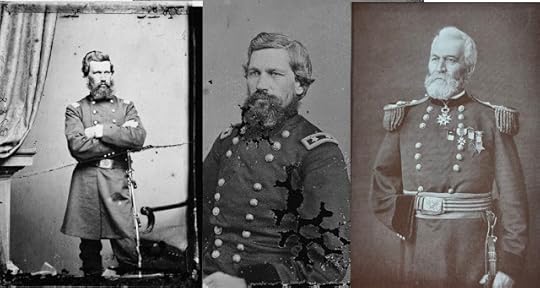 General Oliver Otis Howard served throughout the Civil War, rising from regimental commander to army commander and serving in both eastern and western theaters. The image at left dates from before Fair Oaks; the one at center from about 1863 when he was leading the 11th Army Corps, and the one at right from around the time he wrote his autobiography in the early 1900s.
General Oliver Otis Howard served throughout the Civil War, rising from regimental commander to army commander and serving in both eastern and western theaters. The image at left dates from before Fair Oaks; the one at center from about 1863 when he was leading the 11th Army Corps, and the one at right from around the time he wrote his autobiography in the early 1900s. On the morning of June 1st, matters had shapedthemselves fairly well for us. From right to left in a bend, concave towardSmith and Longstreet, were the divisions of Sedgwick, Richardson, Kearny, andHooker. Sumner’s troops were at the extreme right, parallel to the Nine-MileRoad. The Union line then ran along the railway and finally crossing therailway and turnpike it continued on by the strong works near Savage Station toWhite Oak Swamp.
Of our division on Sedgwick’s left, French’s brigade of fourregiments was the front line with my 5th New Hampshire stillcovering the whole front as a picket guard. The remainder of my brigadeconsisting of the 64th New York (Colonel Thomas J. Parker), 61stNew York (Colonel Francis C. Barlow), and 81st Pennsylvania (Colonel James Miller) formed a second line a few hundred yards back. General Thomas Meagher’sbrigade of three regiments made a third line with Hazzard’s, Frank’s, and Petit’sbatteries of our division located on convenient knolls near the front. Thus, atdawn we stood ready for work.
As soon as it was light, the 5th New Hampshireunder Colonel Edward E. Cross advanced slowly till it had seized the woodsbeyond the railroad near Fair Oaks Station. Hazzard quickly found a favorableplace for the batteries, whence by a crossfire he commanded all the open spacesover which the enemy would have to approach us. The guns and battery men wereshielded by epaulements hurriedly thrown up.
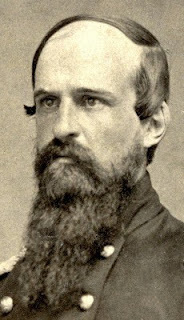 Colonel Edward E. Cross
Colonel Edward E. Cross5th New Hampshire
The first noisy collision of this Sunday morning was about 5o’clock; it became a smart reveille to all; first, a brisk skirmish, a fewbullets whizzing through the treetops. Colonel Cross had every man ready andthe artillery officers with good field glasses were watching. There was alwaysa strange thrill of interest at such a time. The movement was, however, only aConfederate reconnaissance. The reconnoiterers were hunting for the Fair Oaks railroadstation which, unbeknownst to them, had changed occupants. For a brief period,they cavalry and infantry showed in the openings along our front but everywherefound themselves met by Cross’s skirmishers whose steady firing, supported bythe rapid crossfire of our batteries, drove them beyond range.
This event increased our caution. Too long an interval wasreported between French and Birney of Kearny’s division with only picketsconnecting the two brigades. French then gained ground to the left, thinninghis ranks and taking a greater distance from Sedgwick. Still, he could notreach far enough so by General [Israel] Richardson’s order I sent ColonelMiller with the 81st Pennsylvania. Miller promptly deployed his menand moved forward till abreast of Colonel Brooke who commanded French’s leftregiment. The reason for not connecting with Birney’s brigade, now undercommand of Colonel Ward, was that it was much farther back from the enemy thanFrench expected to find it and the underbrush was too thick to see very far.
Sumner was now the senior officer south of the Chickahominy,but in command of his own corps only and Heintzelman commanded his part of theline. The commander of the whole battle was McClellan at his headquartersseveral miles away. The day’s work resulted in spasmodic activities at severalpoints of our front and no general aggressive movement even after theConfederate partial attacks had been repulsed.
The 5th New Hampshire was relieved from theskirmish line and placed in reserve. There were but a few minutes to wait. UponFrench’s left front there came a Confederate attack with two deployed brigadefronts, Armistead’s and Pickett’s. They moved at a quick walk and, owing to theprevalence of the woodland, drew wonderfully near before they were discovered.Along the whole of our front line, they opened a heavy rolling fire of musketrywithin 50 yards. French’s men instantly returned the fire and the contest overan hour was as severe as any in the war.
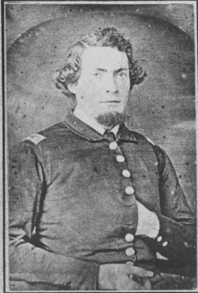 Colonel James Miller
Colonel James Miller81st Pennsylvania
Killed at Fair Oaks
At this time, Miller of my brigade who was to the left sawthrough the trees the advancing troops. He gave the word “ready” when someofficer near him said, “No, colonel, they are our own men!” Probably thinkingthem detached from Ward, Miller in his strong voice commanded, “Recover arms,”then called out “Who are you?” They cried out, “Virginians!” and instantlyfired a volley which killed Colonel Miller and so many of his men that theregiment lost its continuity. A captain, Robert M. Lee, Jr., [Co. F] sprangupon a stump near at hand and rallied six companies. At once I sent LieutenantNelson A. Miles to look up the other four companies. He soon found them and broughtthem together at the railroad where there was an open space and then led themagain into action.
It was at this period of the conflict that Richardson sent tome to fill the interval made worse by the loss of Miller. I brought tworegiments into line at the railroad: the 61st New York on the rightand the 64th New York to its left. Just as we were ready to advance,the enemy’s fire began to meet us, cutting through the trees. My brown horsewas wounded through the shoulder and I had to dismount and wait for another. Turningtowards the men, I saw that some had been hit and others were leaving theirranks. This was their first experience under fire. I cried out with all mymight, “Lie down!” Every man dropped to the ground; then my staff and the fieldofficers aided me in sheltering the men by forming line behind the railroadembankment, but we could not fire yet without the danger of pouring shot intoFrench’s line.
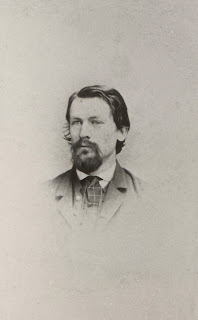 Lieutenant Charles H. Howard.
Lieutenant Charles H. Howard. Oliver's younger brother
In five minutes, I had mounted my large gray horse, my brotherriding my third and only other one, a beautiful “zebra.” In order to encouragethe men in a forward movement, I placed myself mounted in front of the 64thNew York and my aide Lieutenant Charles H. Howard in front of the 61stNew York. Every officer was directed to repeat each command. I ordered “Forward”and then “March!” I could hear the echo of these words and, as I started, the64th New York followed me with a glad shout up the slope and throughthe woods. The 61st New York followed my brother at the same time.We moved forward finely, taking many prisoners as we went and gaining ground tothe left until we came abreast of French’s division.
Before reaching French’s line, I was wounded through theright forearm by a small Mississippi rifle ball. Lieutenant Howard just thenran to me on foot and said that the zebra horse was killed. He took ahandkerchief, bound up my arm, and then ran back to the 61st NewYork. As the impulse was favorable to a charge, I decided to go on farther andasking Brooke’s regiments on French’s left to lie down, called again, “Forward!”
And on we went, pushing back the enemy and breaking throughhis nearest line. We pressed our way over uneven ground to the neighborhood ofthe crossroads of Seven Pines where our men the day before had left their tentsstanding. Behind those tents was found a stronger force of Confederateskneeling and firing. We approached within 30-40 yards and halted on asfavorable ground as possible before promptly and efficiently returning theirfire.
When at last we halted near the standing tents and I hadpassed to the rear of the line which was rapidly firing, my gray had his leftforeleg broken and though I was not then aware of it, I had been wounded again,my right elbow having been shattered by a rifle shot. My brother LieutenantHoward was missing. Lieutenant William McIntyre of the 61st New Yorksaw the condition of my horse and seized me, putting me in a sheltered piece ofground. I heard him say, “General, you shall not be killed.” McIntyre himselfwas slain near that spot, giving his life for mine.
The bullets were just then raining upon our men who, withoutflinching, were firing back. As a faintness warmed me, I called to Colonel Barlowwho was nearby to take command. He answered me in a clear, cool voice, “Shall Itake command of the whole brigade, sir?” I replied, “No, only this portion.” Itwould have broken Cross’s heart to have forgotten even at such a time hisseniority and the colonel of the 64th New York who was also Barlow’ssenior, but he had failed in the necessary physical strength that day.
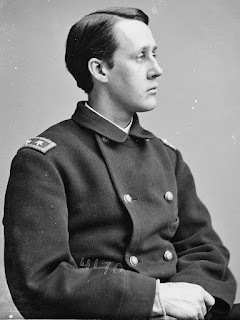 Colonel Francis C. Barlow
Colonel Francis C. Barlow61st New York
Barlow took command and stood his ground until Brooke, to whomI spoke on my way to the rear, brought up his line. After a little further conflictin that vicinity, the Confederates gave way and along our division front, thevictory was complete. General French’s medical director, Surgeon Gabriel Grant,[2nd New Jersey, later a Medal of Honor recipient for this act] wasoperating under fire besides a large stump close up to the troops. There hebound up my arm. I found my brother shot through the thigh, just able to limpalong by using his empty scabbard for a cane.
Dr. Grant dressed his leg and provided him with a stretcher.I preferred to walk. En route, I encountered a soldier among the wounded withhis fingers broken and bleeding. He cried out with pain. Seeing me he drew nearwith sympathy. “You are worse off than I,” he said and putting his arm aroundme, he let me share his strength. We wounded wanderers at last found Courtney’shouse a half mile or more north of the Fair Oaks Station.
Dr. Hammond, my personal friend, met me near the house, sawthe blood, touched my arm and said with feeling, “General, your arm is broken.”The last ball had passed through the elbow joint and crushed the bones intosmall fragments. He led me to a Negro hut, large enough only for a double bed. HereI lay down, alarming an aged Negro couple who feared at first that some of usmight discover and seize hidden treasure which was in that bed.
My brigade surgeon Dr. Palmer and several others soon stoodby my bedside in consultation. At last Dr. Palmer with a serious face kindlytold me that my arm better come off. “All right, go ahead. Happy to lose only myarm,” I said.
“Not before 5 p.m., general.”
“Why not?”
“Reaction must set in.”
So, I had to wait six hours. I had received the second woundat about 10:30 that morning. I had reached the Courtney house about 11 and, insome weakness, and discomfort occupied the Negro cabin till the hour appointed.At that time, Dr. Palmer came with four stout soldiers and a stretcher. They meupon it and the doctor put around the arm a torniquet close to the shoulder,screwing it tighter and tighter above the wound. They then bore me to theamputating room, a place a little gruesome withal from arms, legs, and handsnot yet carried off and poor fellows with anxious eyes awaiting their turn.
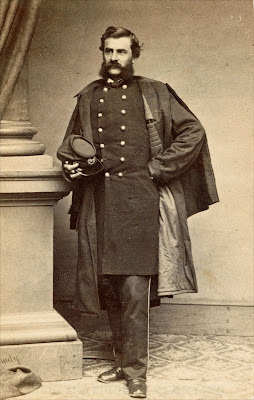 Surgeon Gabriel Grant
Surgeon Gabriel Grant2nd New Jersey
Medal of Honor
On the long table I was nicely bolstered; Dr. Grant, who hadcome from the front, relieved the too-tight torniquet. A mixture of chloroformand gas was administered and I slept quietly. Dr. Palmer amputated the armabove the elbow. When I awoke I was surprised to find the heavy burden was gonebut was content and thankful. The next morning [June 2, 1862] my brother and Iset out on leave with a surgeon’s certificate of disability.
I rode beside the driver of the ambulance to Fair Oaksstation. I had had reached the ground at the station when General Philip Kearnyrode up with his staff. They dismounted and stood near us while Kearny and Igrasped hands. He had lost his left arm in Mexico. To console me, he said in agentle voice, “General, I am sorry for you, but you must not mind it. Theladies will not think the less of you!” I laughed as I glanced at our two handsof the same size and replied, “There is one thing we can do, general. We canbuy our gloves together!” He answered with a smile, “Sure enough!” But we didnot, for I never met him again. He was killed at Chantilly on September 1,1862.
Source:
Howard, Oliver Otis. Autobiography of Oliver Otis Howard, Major General, UnitedStates Army. Volume 1. New York: The Baker & Taylor Co., 1907, pgs.242-251
September 4, 2025
A Captured Sword and Lost Story of the Battle of Stones River
In November 1900,R.A. Miller, formerly a Confederate line officer, wrote a short note to thelocal newspaper editor advertising for the return of a sword he had capturedduring the Civil War. “I have a sword captured in the battle of Murfreesboro onthe 31st of December 1862,” he wrote. “The name on the scabbard isI. Abernathy, lieutenant, 37th Indiana Volunteers. I was woundedseverely a few minutes after. I was a lieutenant in command of Co. B, 24thMississippi Volunteers. The sword will be returned on application of partiesinterested.”
To start off, who was Lieutenant R.A.Miller of the 24th Mississippi, and how did he come to be wounded onthe battlefield of Stones River? And who was I. Abernathy of the 37thIndiana and what was his fate? Let’s explore those questions a bit.
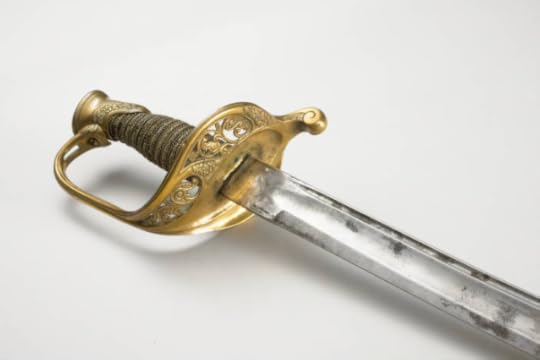 We don't know for sure exactly what type of sword Lieutenant Abernathy was carrying at Stones River but the type most commonly carried was the Model 1850 Foot Officer's Sword like the one pictured above. The lieutenant's sword was engraved with his name and regiment.
We don't know for sure exactly what type of sword Lieutenant Abernathy was carrying at Stones River but the type most commonly carried was the Model 1850 Foot Officer's Sword like the one pictured above. The lieutenant's sword was engraved with his name and regiment. The Index to Compiled Confederate Military Service Recordsshows that Robert A. Miller enlisted as a private in Co. B of the 24thMississippi but has no further record. Co. B had a company monicker of the “MississippiConfederates;” every company in the regiment had a monicker ranging from the Co.H who called themselves the “Buena Vista Hornets” to Co. E who were the “HelenJohnstone Guards.” The regiment was raised in response to Governor John J. Pettus’scall for three-years enlistment and was “made up largely of very young men. Thecompanies were assembled at Marion Station and mustered into the ConfederateStates service in September and October 1861.”
Fortunately, Fold3 has Lieutenant Miller’s complete servicefile which shows he enlisted August 27, 1861, at West Point, Mississippi andwas promptly promoted to orderly sergeant. By February 12, 1862, he waspromoted to third lieutenant (a rank not typically found in the Union army) andby the time of Stones River was a second lieutenant and apparently in commandof Co. B.
The 24th Mississippi was a well-traveled regimentby the time of Stones River. Shortly after mustering into service, it wasordered to report to General Robert E. Lee’s command at Savannah, Georgia onthe Atlantic coast. “As they were enlisted for the war, General Lee gave themarms intended for Georgia,” a Confederate history noted. “In December, GeneralLee ordered the regiment to Fernandina [Florida] which was exposed to Federalnaval expeditions. The abandonment of the coast soon followed and the 24thwas ordered in late February 1862 to Tennessee. They were not able to start onaccount of limited railroad transportation until late in March. On March 31st,it was ordered detained at Chattanooga with the command of General Samuel B.Maxey.” On April 9th (in the wake of the losses at Shiloh), Maxey’scommand which included the 41st Georgia and 9th Texas wasordered to Corinth where it joined the Army of Mississippi, the predecessororganization to the Army of Tennessee which fought at Stones River.
The regiment would serve in the Army of Mississippi/Tennesseefor the remainder of the war. At the end of May, the army abandoned Corinth andwent into camp near Tupelo, Mississippi to recuperate and reorganize. Now underthe command of General Braxton Bragg, in late July the army moved via railroadand steamboat from Mississippi to Chattanooga, Tennessee. By early September,the army marched into Kentucky. The 24th Mississippi formed part ofColonel Thomas M. Jones’ brigade during the Kentucky campaign.
By the time of Stones River, the 24th Mississippiwas in a new brigade under the command of Colonel Edward Walthall, servingalongside the 45th Alabama, 27th Mississippi, 29thMississippi, and 30th Mississippi, the 10th MissouriBattery and one very late addition, the 39th North Carolina whichjoined the brigade on January 1, 1863, in part to make up for the heavy lossesincurred on December 31. Just a few days before the battle, Brigadier GeneralJ. Patton Anderson assumed command of the brigade while Colonel Walthallreturned home to Mississippi to attend to his sick wife.
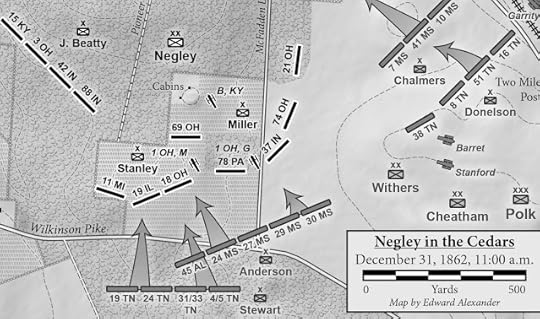 The 24th Mississippi was the left center regiment in Anderson's brigade line at Stones River. Moving in conjunction with the neighboring 45th Alabama, the Mississippians first clashed with portions of Sheridan's division before moving into the cedars and tangling with the two brigades of General James Negley's division of Thomas's Corps.
The 24th Mississippi was the left center regiment in Anderson's brigade line at Stones River. Moving in conjunction with the neighboring 45th Alabama, the Mississippians first clashed with portions of Sheridan's division before moving into the cedars and tangling with the two brigades of General James Negley's division of Thomas's Corps. “The brigade went into line of battle on December 28, 1862,on the left of Chalmers' Brigade, stretching on the right into a dense cedarforest,” a Confederate history reported. “The regiment threw up breastworks ofthe loose stone which covered the ground. The skirmishers were engaged throughthe next two days, and on the 31st the attack began."
Lieutenant Colonel Robert McKelvaine provided some furtherdetails in his after-action report. “The regiment was ordered about 8 a.m. inconnection with the 45th Alabama to support the right of Colonel Manigault’sbrigade and in the event Colonel Manigault’s brigade failed to take a batteryon the right-hand side of the Nolensville Pike in a small prairie or old field,my regiment in connection with the 45th Alabama was to charge thebattery which I did. The first charge my regiment advanced as far as the pikeand I observed that my support on the left was giving way and I here ordered mymen to fall back which was done in good order.”
“A second charge was made and again I wascompelled to fall back for the reason above stated,” McKelvaine continued. “Athird charge was made in which we were successful in taking the battery, theenemy fleeing before us through a small field to a thick cedar grove where theymade a stand for a short time. At this place, I had two men killed and severalwounded. Very soon the ever-memorable General Patton Anderson dashed in frontof my line with his hat off calling for the Mississippians to follow him, whichthe regiment did in good order and new reinforcements joined in the pursuit,the enemy completely demoralized.” [The battery mentioned was Battery G of the1st Ohio Light Artillery which lost several guns in this sector ofthe field.]
As the 24th Mississippi surged north of theWilkinson Pike, the remnants of Sheridan’s division fell back through thecedars before them, unmasking the right flank of General James Negley’sdivision. The right flank brigade under Colonel Timothy Stanley soon started tofall back which exposed the left flank brigade under Colonel John F. Miller, whosecommand included the 37th Indiana. It was at this point, somewherein the cedars near Tour Stop #2 on the present Stones River National Battlefield,that Lieutenant Miller captured Lieutenant Abernathy’s sword.
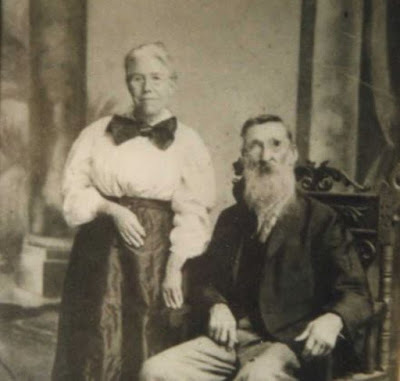 Second Lieutenant Robert A. Miller of Co. B, 24th Mississippi seated beside his wife Martha in an image likely dating from around 1900, the same time that he was trying to reunite Lieutenant Abernathy's sword with his family or comrades. Severely wounded shortly after recovering the sword on the battlefield, Miller would spend most of the next two years in various hospitals before being discharged in December 1864.
Second Lieutenant Robert A. Miller of Co. B, 24th Mississippi seated beside his wife Martha in an image likely dating from around 1900, the same time that he was trying to reunite Lieutenant Abernathy's sword with his family or comrades. Severely wounded shortly after recovering the sword on the battlefield, Miller would spend most of the next two years in various hospitals before being discharged in December 1864.In a January 21, 1863, report of thecasualties sustained by Walthall’s Brigade during the campaign, LieutenantMiller is listed as being severely wounded in the leg around noon on December31, 1862, and “near the cedar thicket.” A casualty list crafted by AdjutantW.W. Robinson and shared with the Mobile Advertiser & Registerconfirms this fact. He was sent to the hospital and apparently went South withthe army when they retreated from Murfreesboro in the early morning hours ofJanuary 4, 1863. Subsequent records make it clear that he was sent to thehospital in Columbus, Mississippi and despite months of recuperation, was neverable to return to duty. Consequently, he was retired December 7, 1864, andcleared from the rolls of the 24th Mississippi.
A quick check of Find-A-Grave revealedthat Robert Andrew Miller was born February 27, 1833, in Lynchburg, Virginia,and moved to Mississippi in the 1850s. On August 4, 1859, he married his wifeMartha Jane McDowell (a 17-year-old South Carolinian) with whom he had sixchildren: William McDowell Miller born in 1860, Sarah Duncan “Sallie” Miller in1864, Robert Esmond Miller in 1869, Margaret Elizabeth Miller in 1872, PowhatanStaples Miller in 1875, and Agnes D. Miller in 1878. The 1860 Federal censusshows Miller and his wife residing at Starkville, Oktibbeha County, Mississippiwhere he was working as a house carpenter. Lieutenant Miller lived a long and active lifeas a farmer despite his wound, passing away July 22, 1911, in West Point,Mississippi at the age of 78. He is buried at Greenwood Cemetery in West Point.
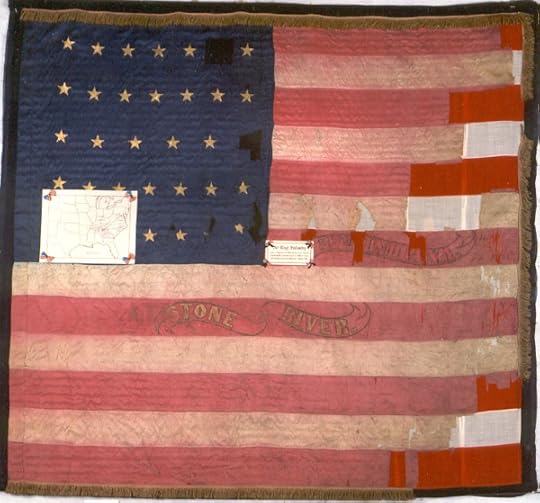 The national colors of the 37th Indiana may have been the last thing Lieutenant Abernathy saw on the battlefield at Stones River. The colors above carry the single honor for Stone River, the regiment's first severe engagement and its costliest of the Civil War. My great-great grandfather was there, fighting in the ranks of Co. D.
The national colors of the 37th Indiana may have been the last thing Lieutenant Abernathy saw on the battlefield at Stones River. The colors above carry the single honor for Stone River, the regiment's first severe engagement and its costliest of the Civil War. My great-great grandfather was there, fighting in the ranks of Co. D. Who was I. Abernathy of the 37thIndiana? A quick check of the Report of the Adjutant General of the State ofIndiana reveals that it was First Lieutenant Isaac Abernathy of Co. K. Aresident of Knightstown, Rush County, Indiana, he was commissioned as a second lieutenantin Co. I on September 10, 1861, and was promoted to first lieutenant and transferredto Co. K on November 24, 1861. He was killed in action December 31, 1862, atStones River and was later buried at Mount Union Cemetery in Union Township,Ross County, Ohio. He was a bachelor.
Unfortunately, I have been unable tofind a more specific account detailing the circumstances of LieutenantAbernathy’s death; this letter from Sergeant William R. Hunt of Co. K providingthe best description. “About 9 o’clock a.m., General Negley’s division becameengaged and the 37th Regiment went into the fight about that time.Our company went in with 46 men besides the captain and Lieutenant Abernathy.We fought them about half or three quarters of an hour. We were then ordered tofall back as the enemy were about to outflank us. They were then pouring a hotfire into us from the front and back flanks. We lost 19 of our company killedand wounded, namely the killed being Lieutenant Abernathy and A.B. Kirkham.”
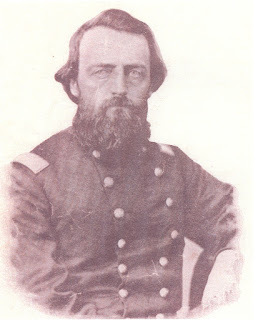 Lt. Col. William D. Ward
Lt. Col. William D. Ward37th Indiana
It wasn’t until January 4ththat the Federal army occupied Murfreesboro and among the first tasks the armyperformed was scouring the battlefield to inter the dead. Captain HezekiahShook of Co. D, 37th Indiana noted in his journal entry for January 11,1863, that “our chaplain [John Hogarth Lozier] preached the funeral sermon of 25of the men of our regiment who were killed in the action before Murfreesboro. Histext was ‘The last enemy that shall be destroyed is death.’ On the 14th,Captain Shook walked over the battlefield where his regiment had fought andobserved “the trees were torn and twisted by cannon balls. Bushes and limbswere shot to pieces. Graves of men were thick over the whole field. But a fewdays ago, those who now lie slumbering here were full of life, health, andhope. In a few moments, they were cut down, their earthly career ended, theirplaces in our ranks left blank, and their hearthstones at home left desolate.With no monument to tell the passer-by, many brave and noble boys rest here,far away from home.”
Interestingly, thanks to Lieutenant Ole R.Dahl who served as typographical officer on Colonel William Carlin’s brigadeand drew a map of the soldiers’ graves at Stones River, we know where on thebattlefield Lieutenant Abernathy was initially buried. Looking at his mapcrafted after the battle, Dahl placed Lieutenant Abernathy’s grave as site 49, withadjacent grave sites 48, 50, and 51 all holding 17 other soldiers of the 37thIndiana. These graves were located north of the Wilkinson Pike and between thePike and the Cowan Burnt House; all of this land is located in the open fieldto the southeast of the Tour Stop #2 parking lot on the battlefield. Since thedead were typically buried close to where they fell, from these gravesites, wecan gain some additional insights into where the 37th Indiana waspositioned when they took their heaviest losses.
One of the things about this storythat intrigues me is that Lieutenant Miller with the 24thMississippi located on the left of Anderson’s brigade moved so far to the east towardsMcFadden’s Lane during the brigade’s attack, really closer to where one wouldhave expected to find the 29th and 30th Mississippiregiments which were the right flank regiments of the line. But both of those regiments had been drivenback and as portions of Anderson’s brigade and A.P. Stewart’s brigade pursuedthe Federals into the cedars, I’m sure there was a great deal of confusion withmaintaining the lines.
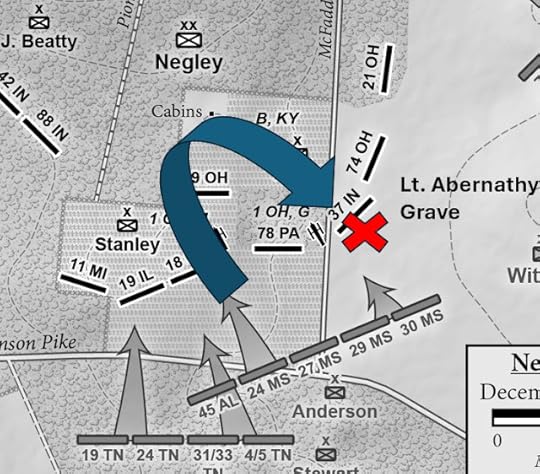
I wish we knew more details. Whether Lieutenant Miller ever was able toreturn the sword to Abernathy’s family or his comrades in the 37thIndiana is lost to history…but having explored its history a bit, I would loveto know if Lieutenant Abernathy’s sword ever made its way into the collector’smarket.
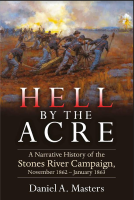 To learn more about the Battle of Stones River, be sure to purchase a copy of my campaign study Hell by the Acre, recently awarded the Richard B. Harwell Award from the Atlanta Civil War Roundtable as best Civil War book of 2024. Available now through Savas Beatie.
To learn more about the Battle of Stones River, be sure to purchase a copy of my campaign study Hell by the Acre, recently awarded the Richard B. Harwell Award from the Atlanta Civil War Roundtable as best Civil War book of 2024. Available now through Savas Beatie.
Sources:
“A CapturedSword,” Macon Beacon (Mississippi), December 29, 1900, pg. 1
Roster of 24thMississippi, Index to Compiled Confederate Military Service Records
M269 CardedRecords Showing Military Service of Soldiers Who Fought in ConfederateOrganizations; entryfor Miller, Robert A., 24th Mississippi
List ofOfficers of 37th Regiment, Indiana Volunteers, Report of theAdjutant General of the State of Indiana
William R.Hunt Letter, Co. K, 37th Indiana, Rare Books and Manuscripts,Indiana Historical Society
Diary ofCaptain Hezekiah Shook, Co. D, 37th Indiana, private collection
Daniel A. Masters's Blog
- Daniel A. Masters's profile
- 1 follower



